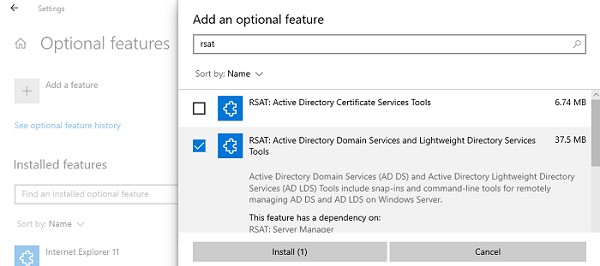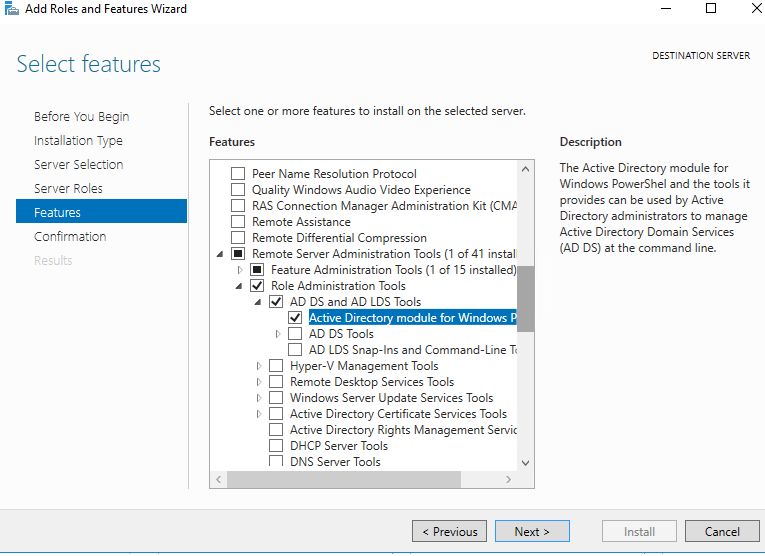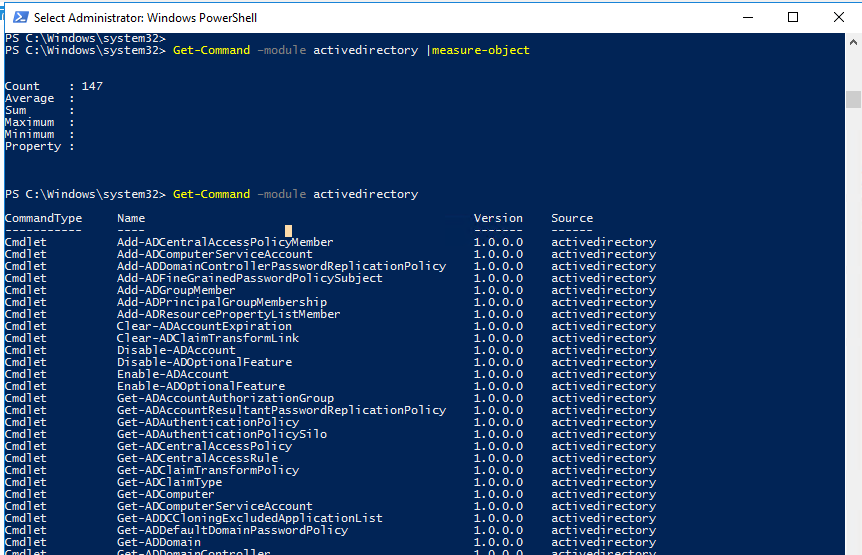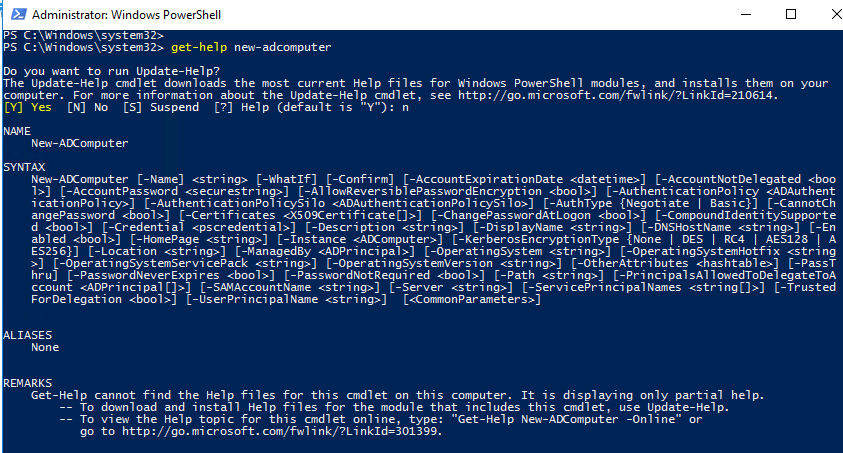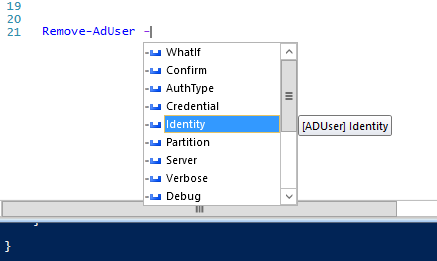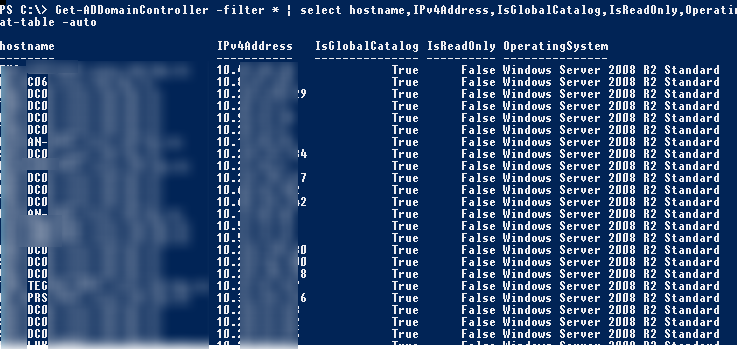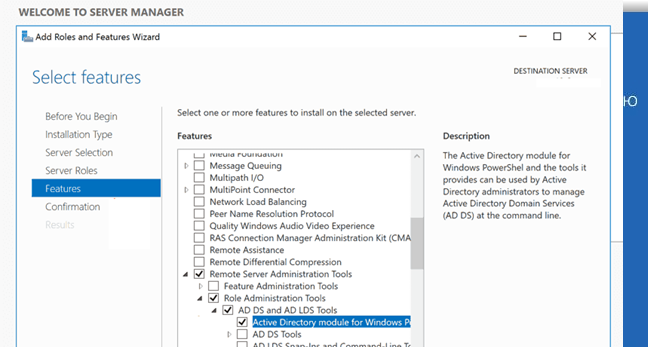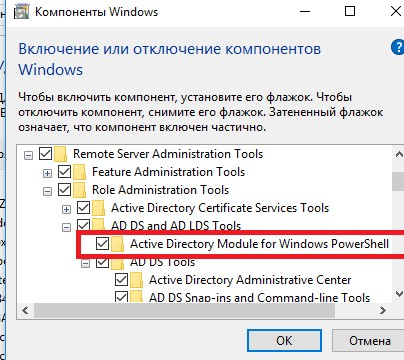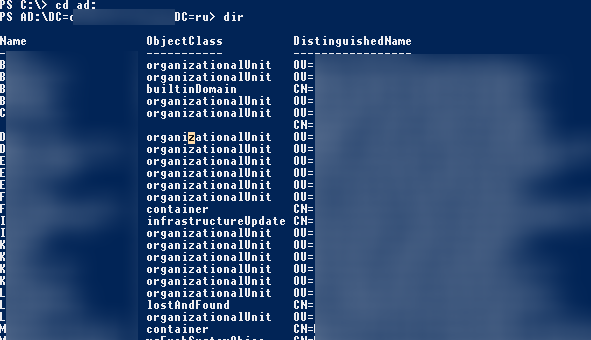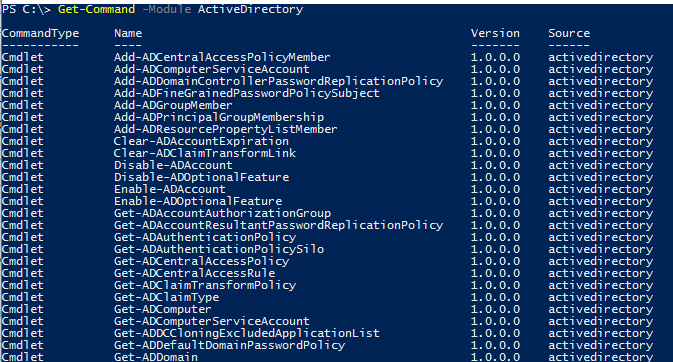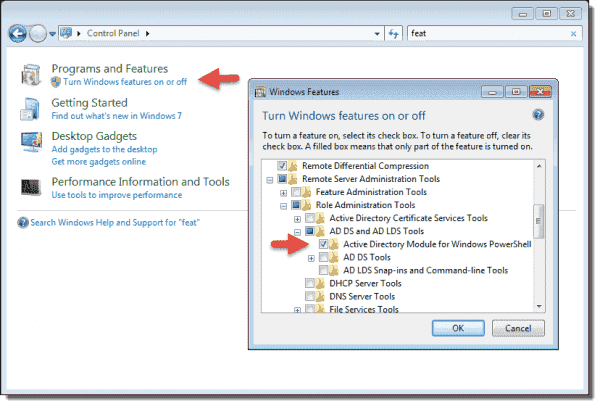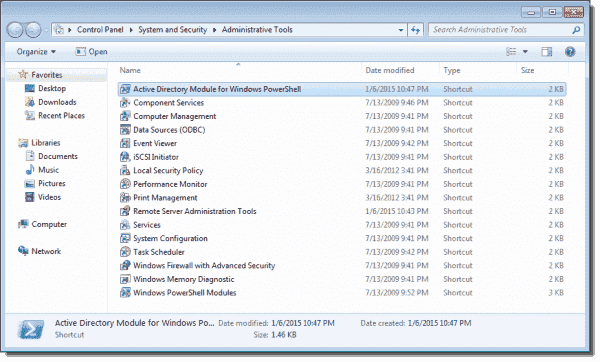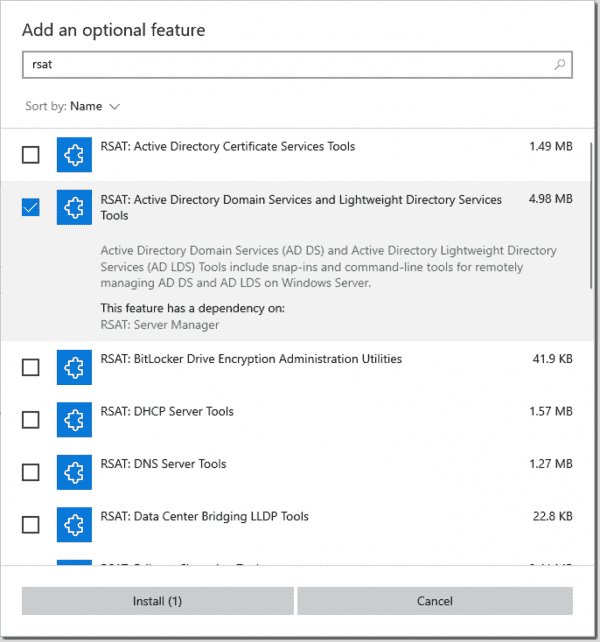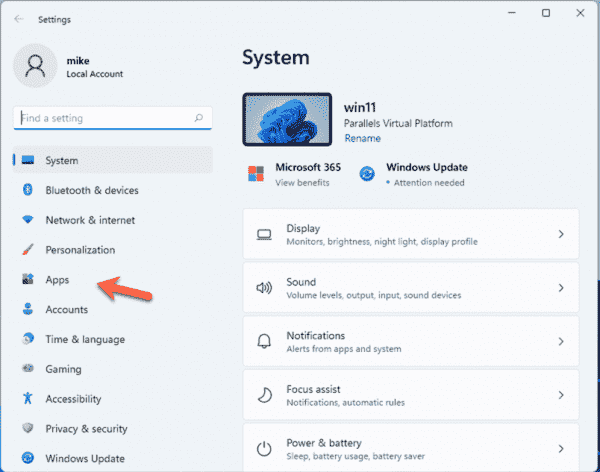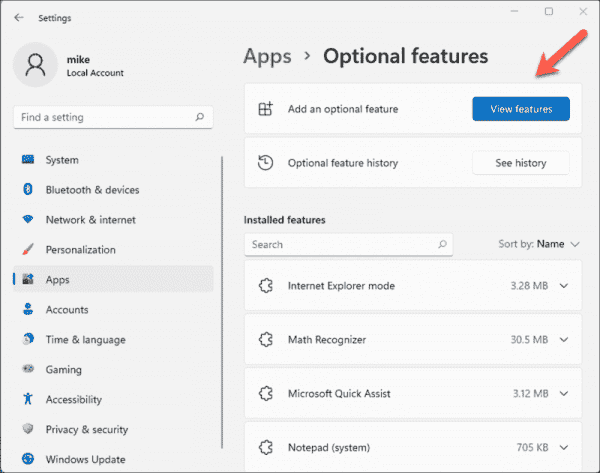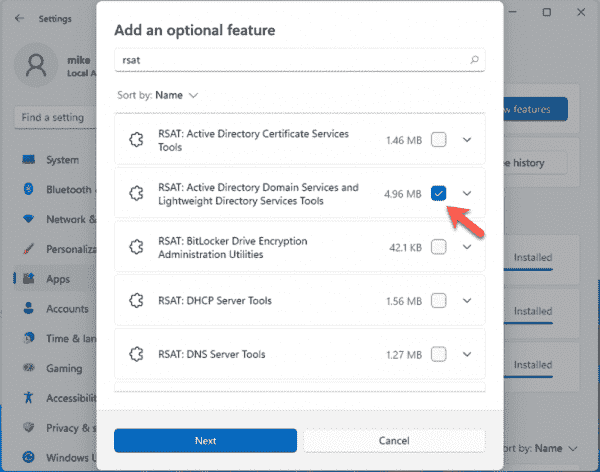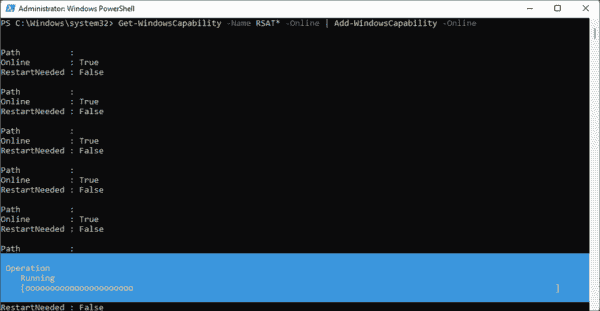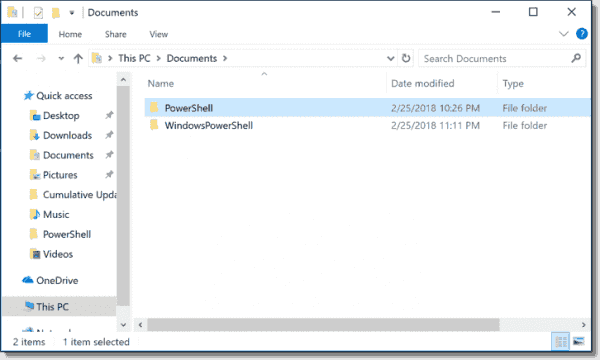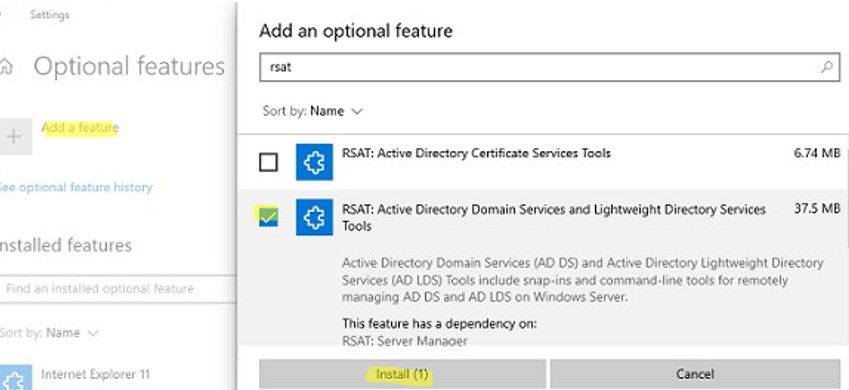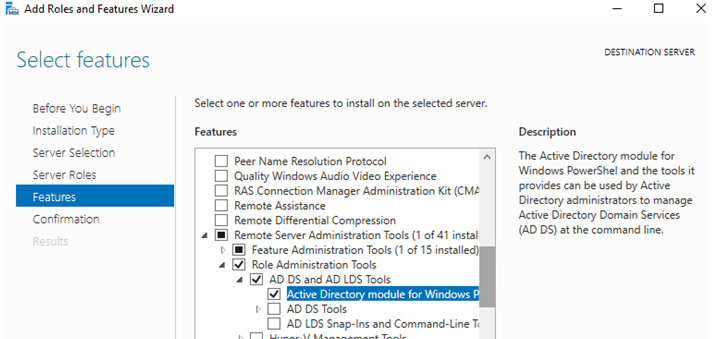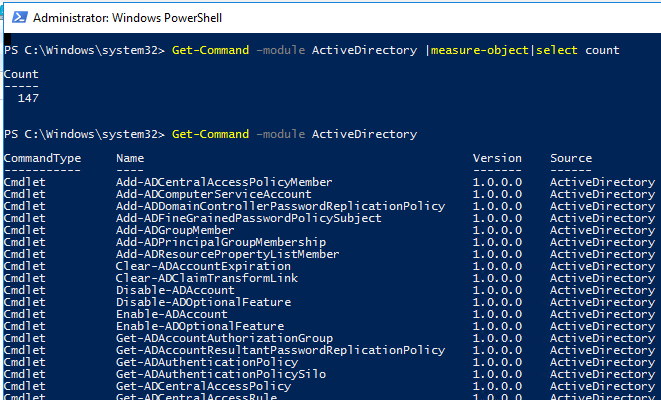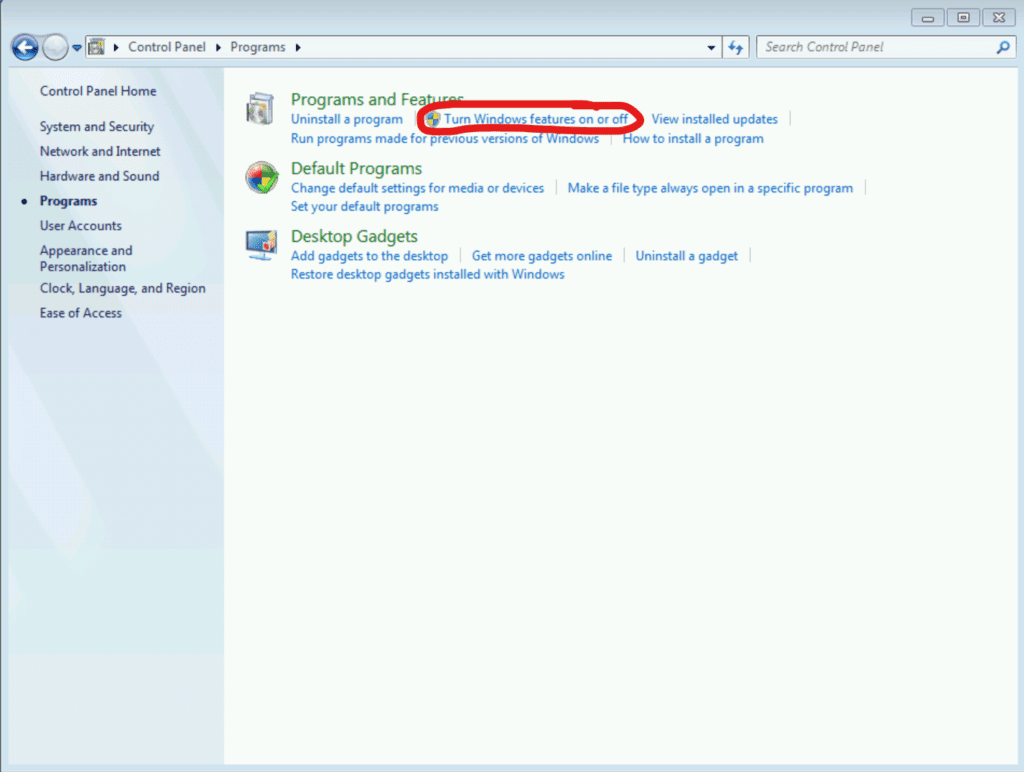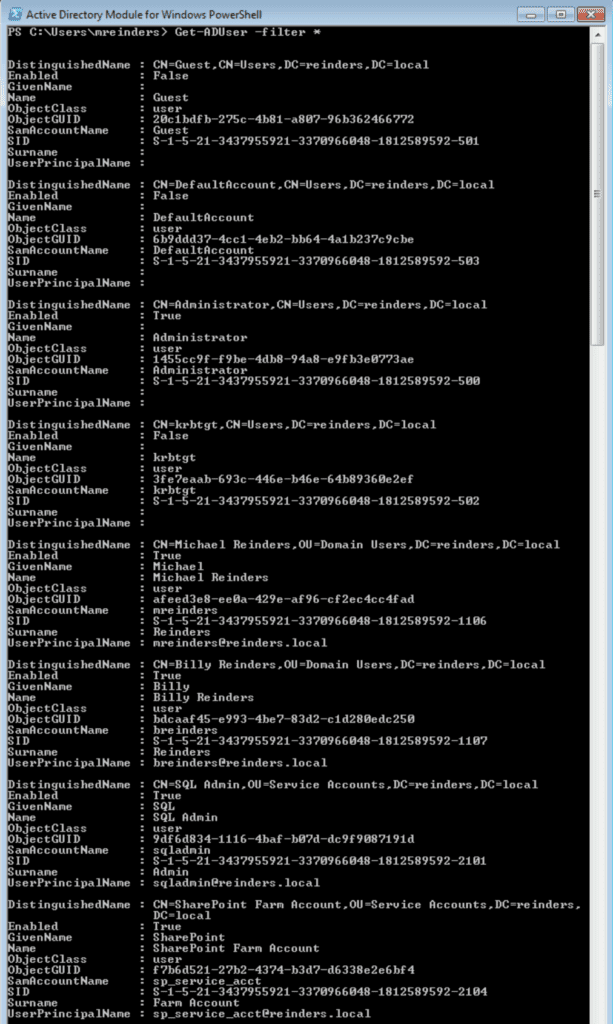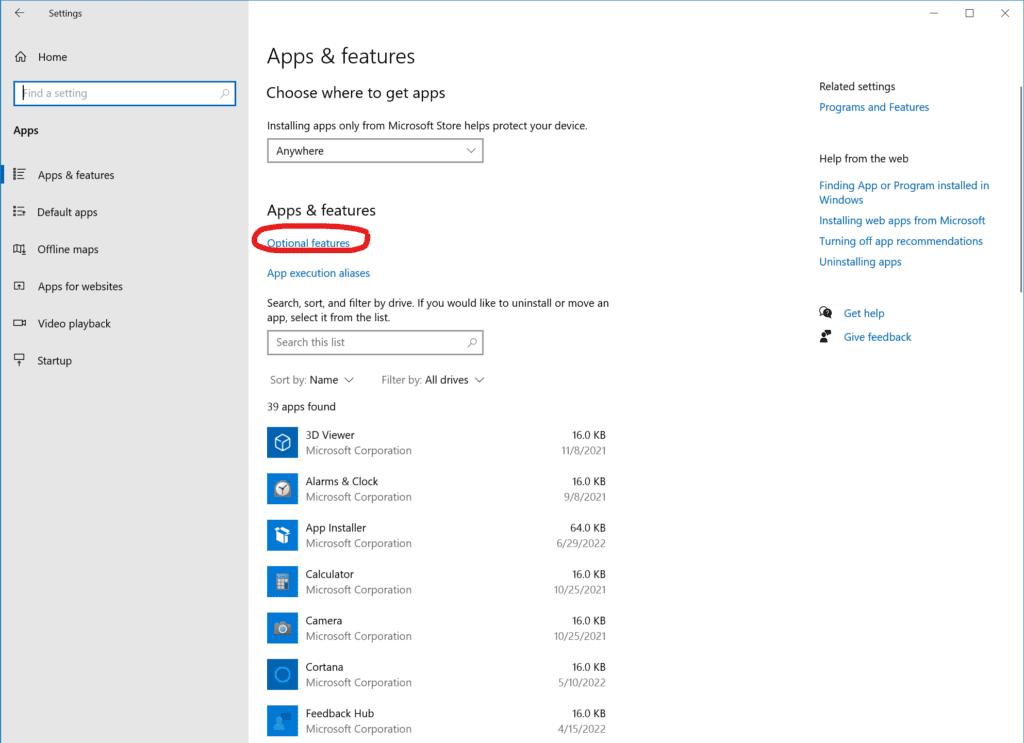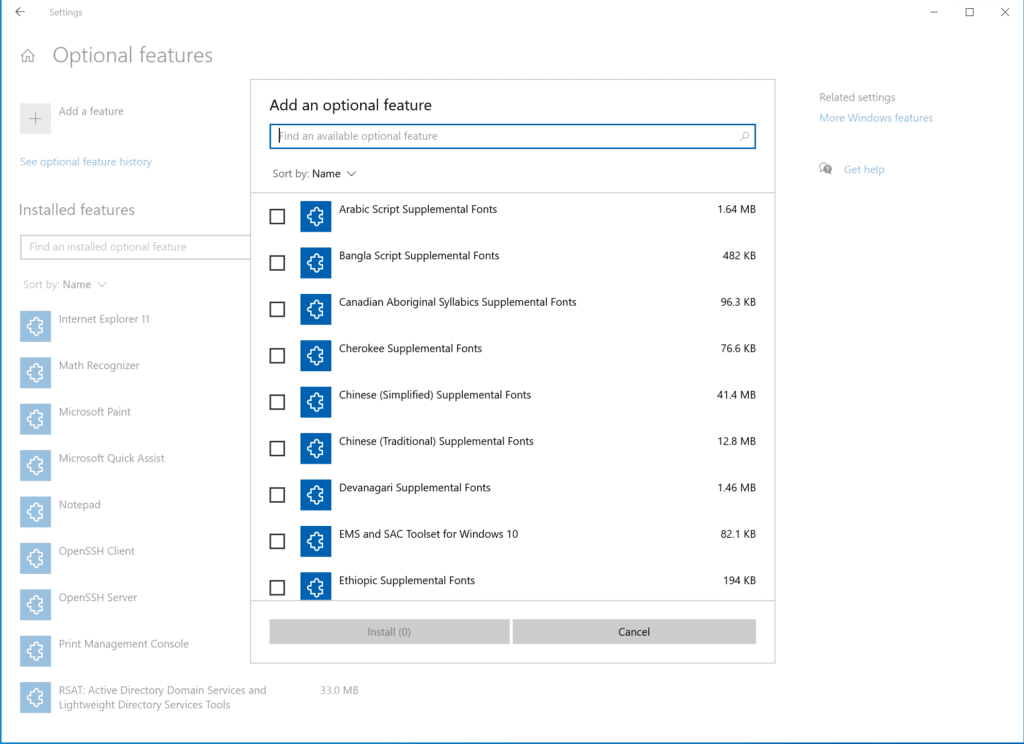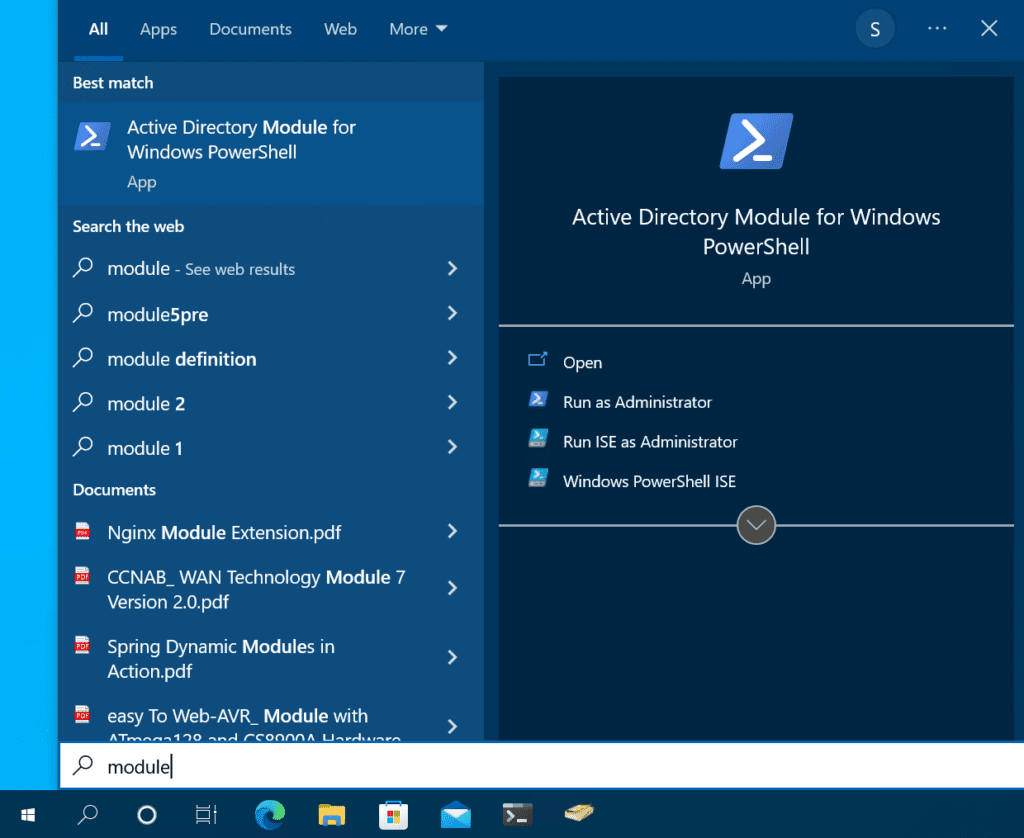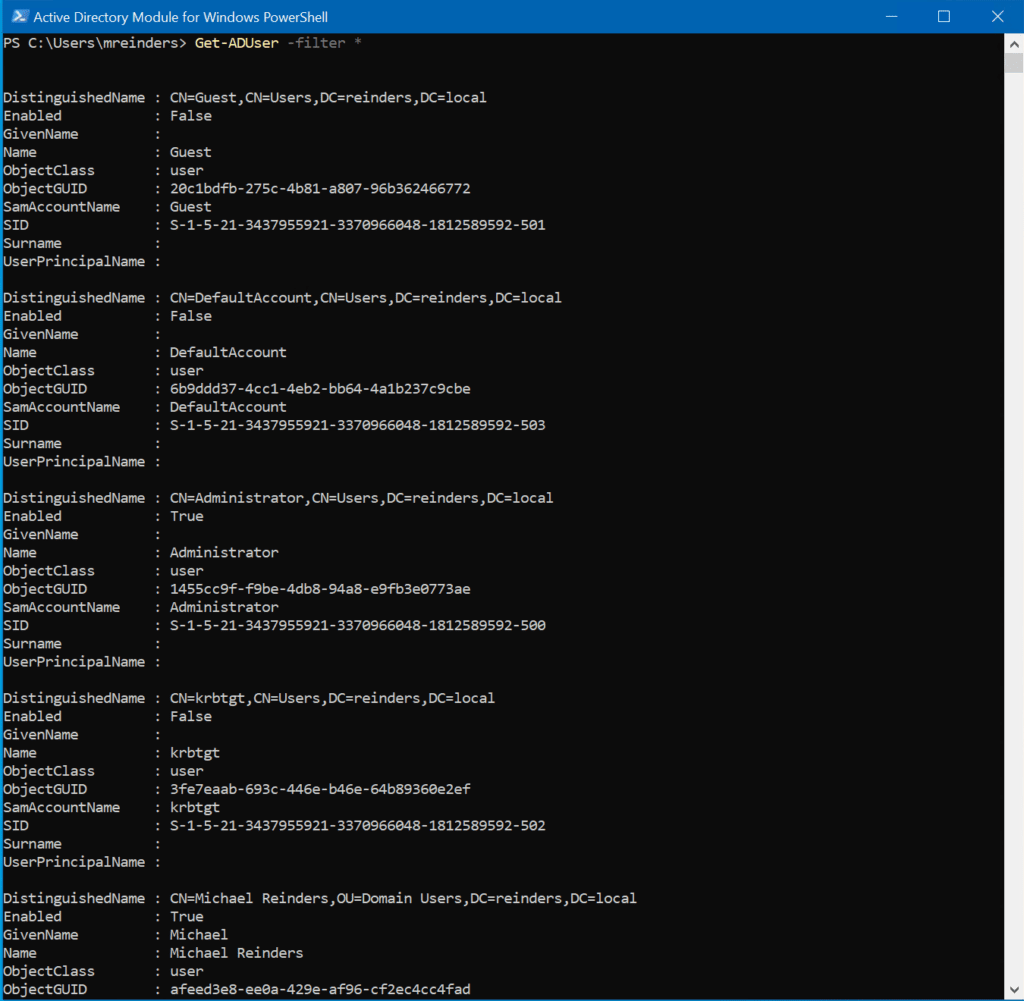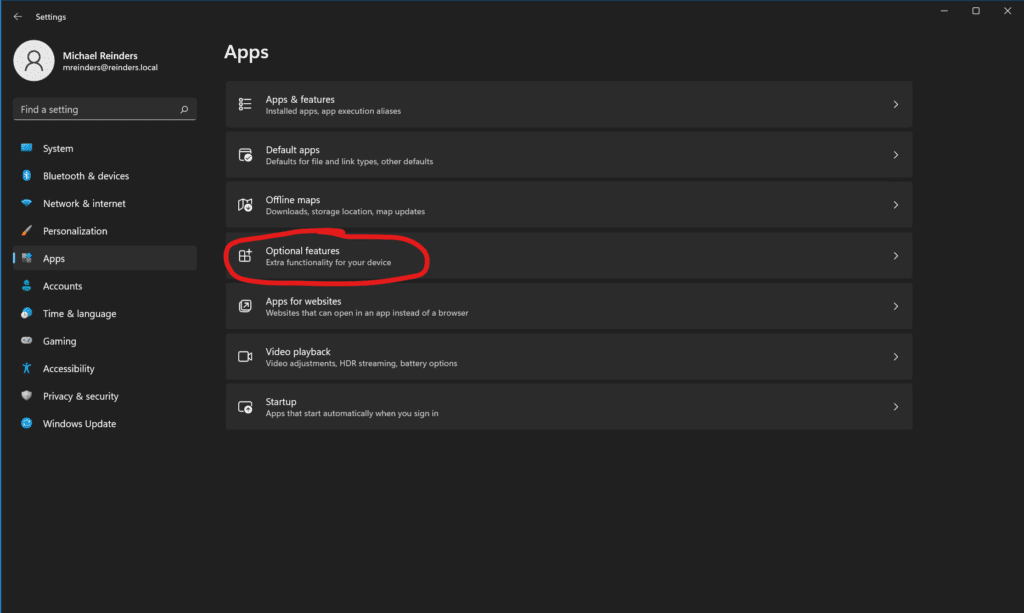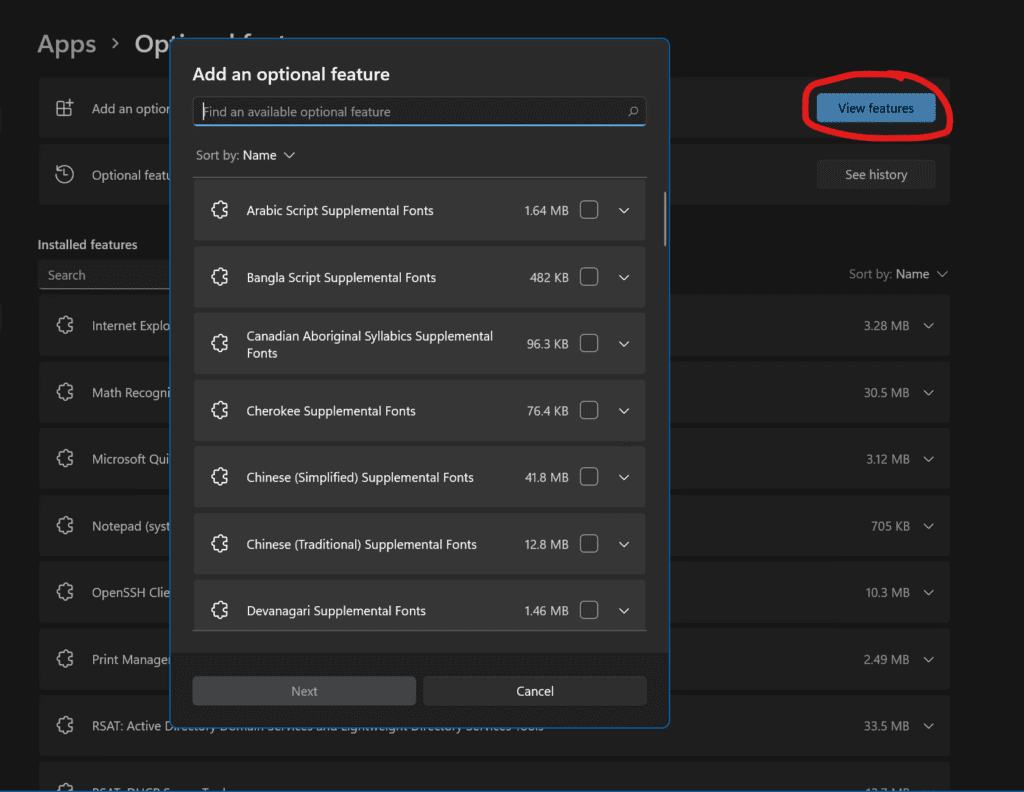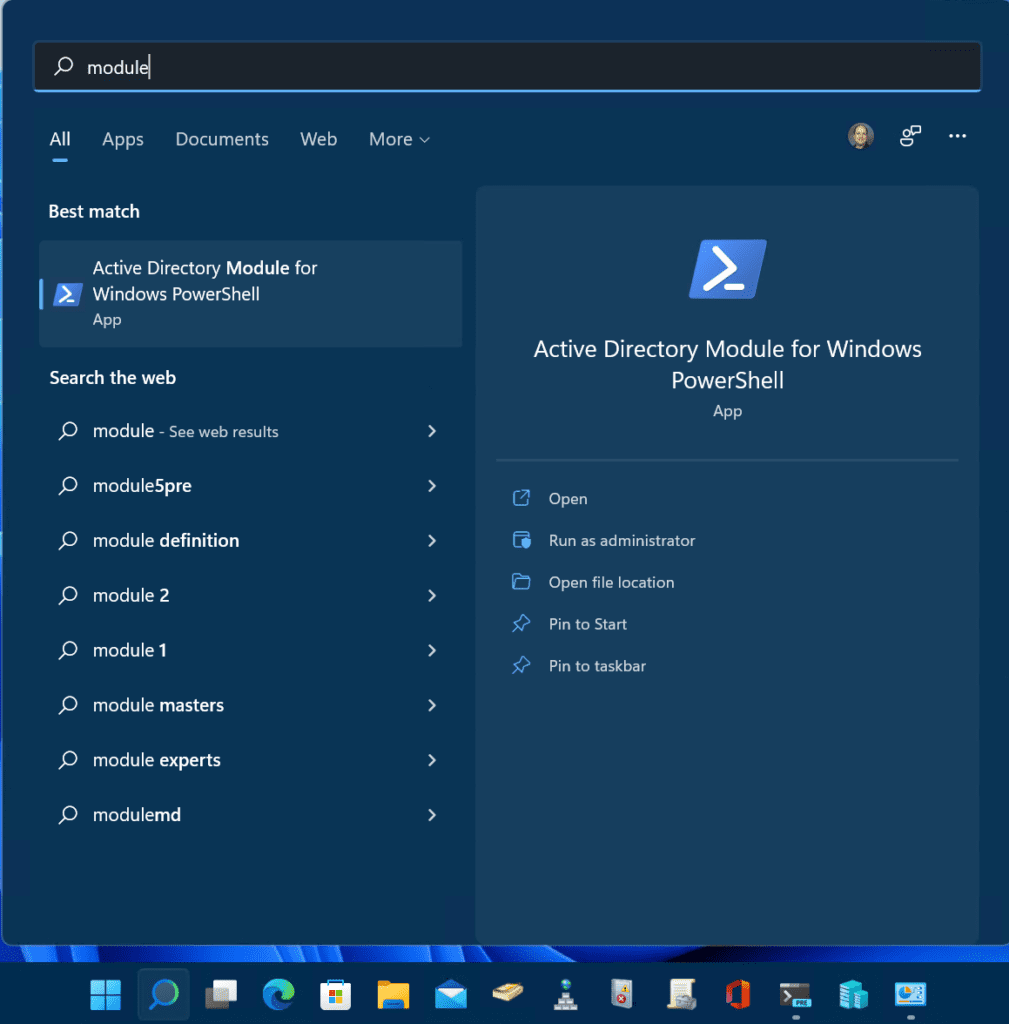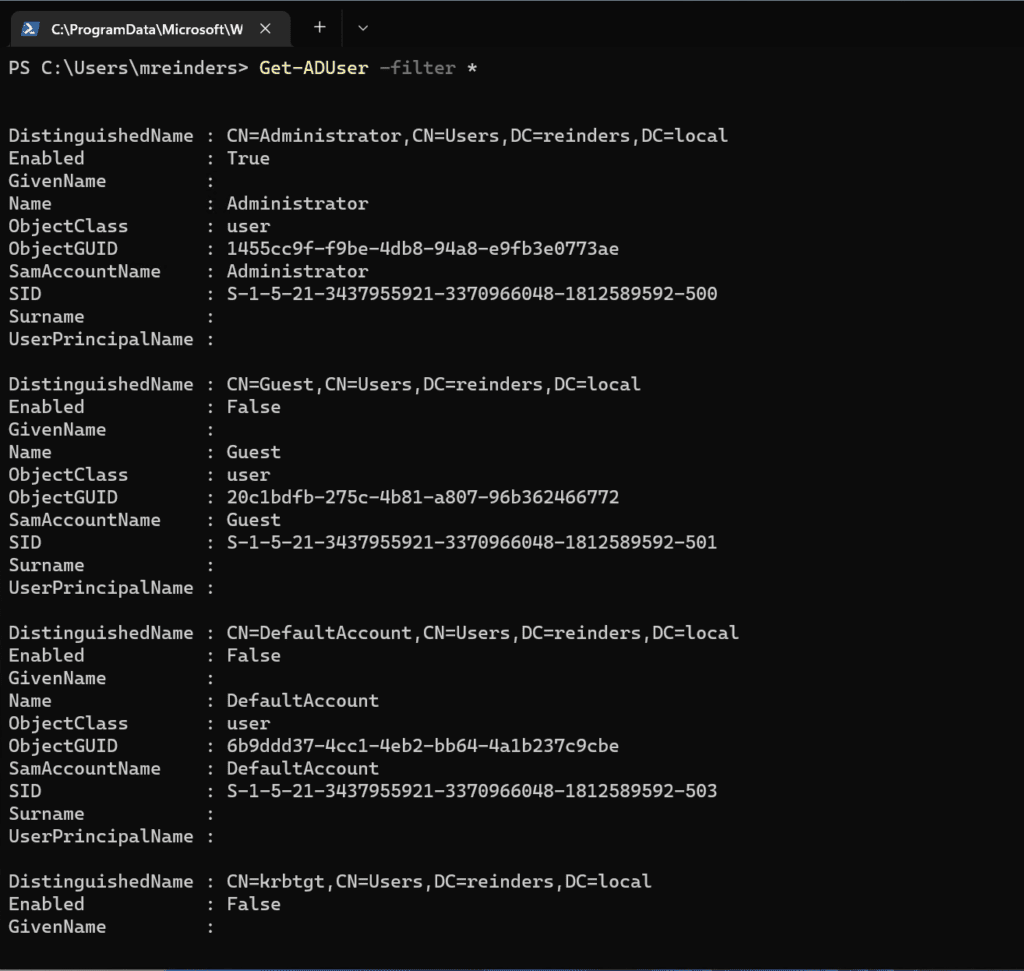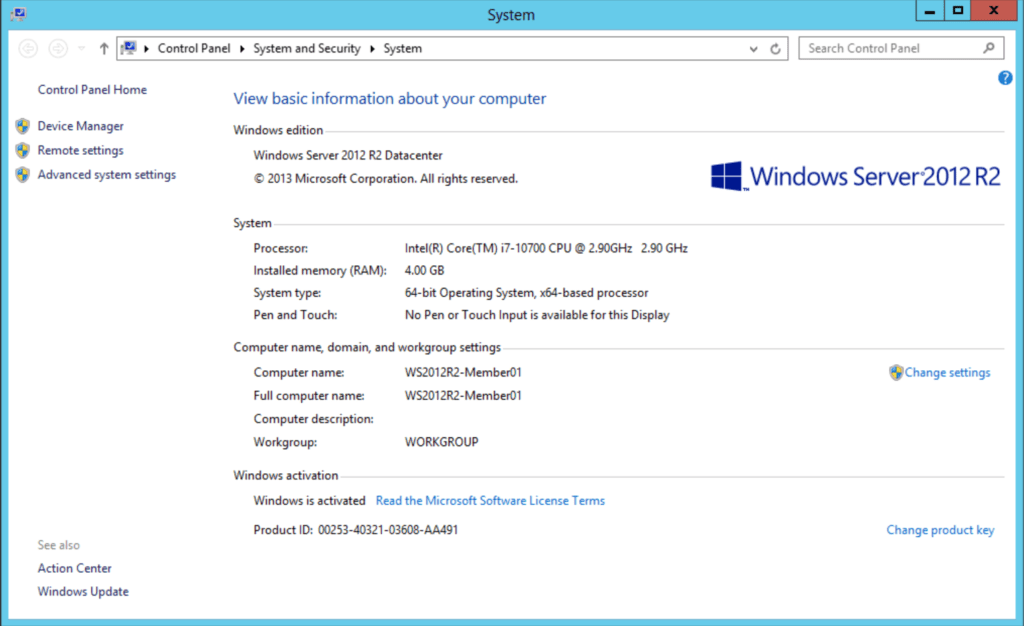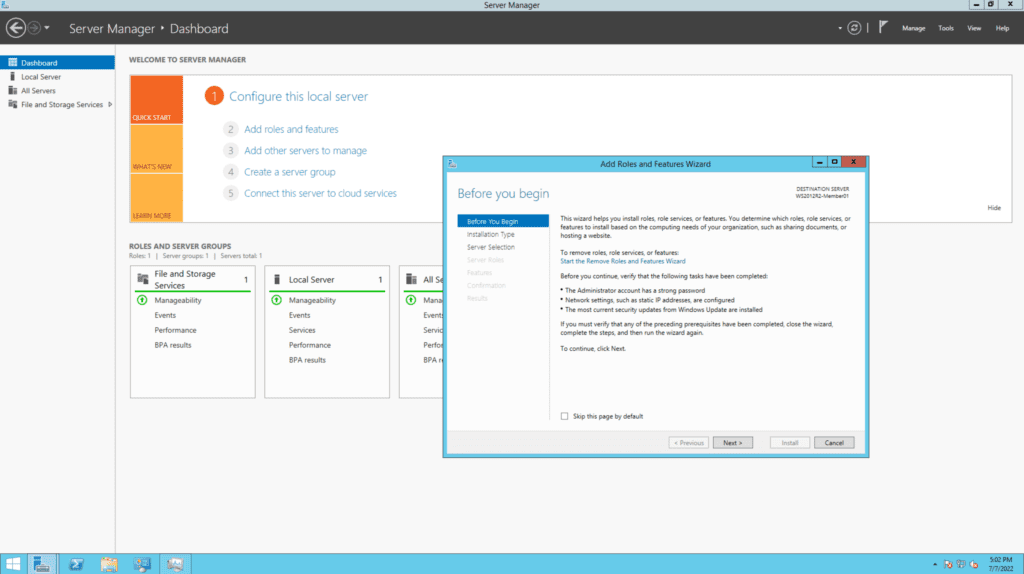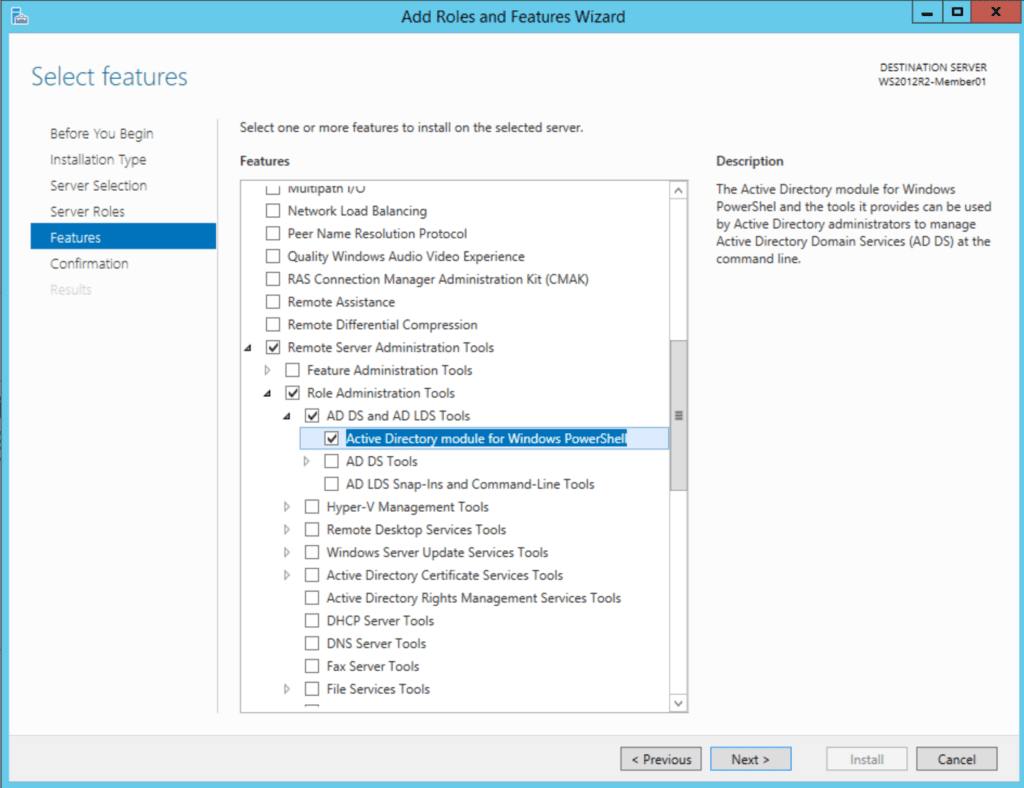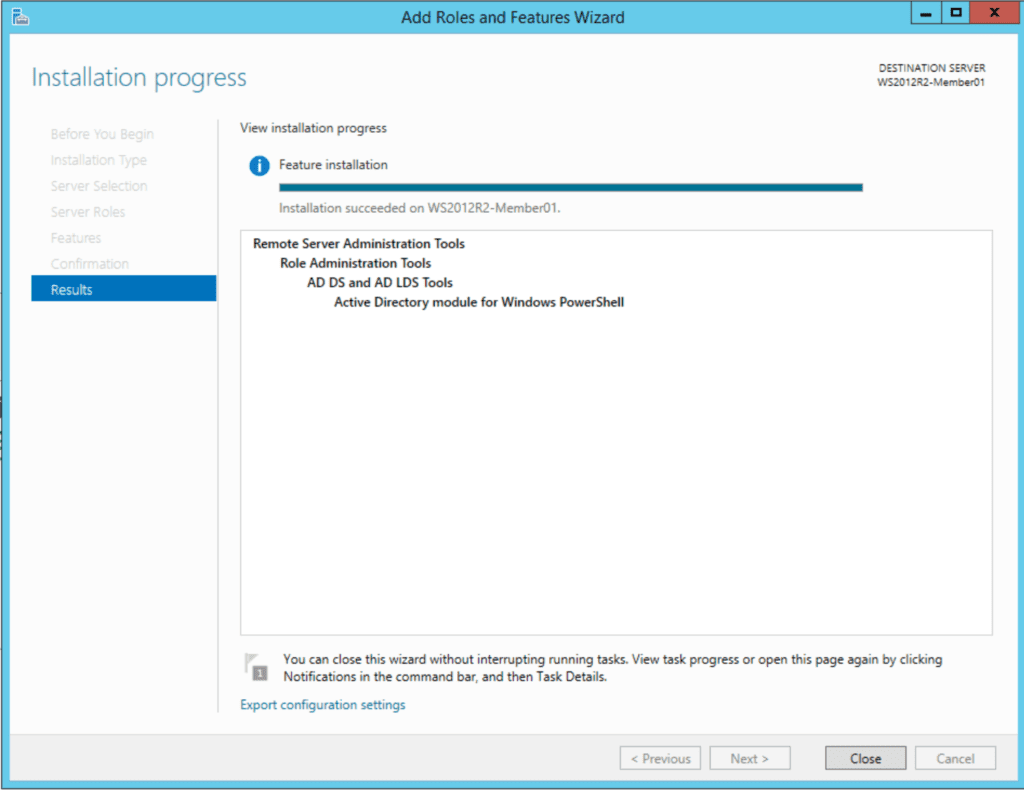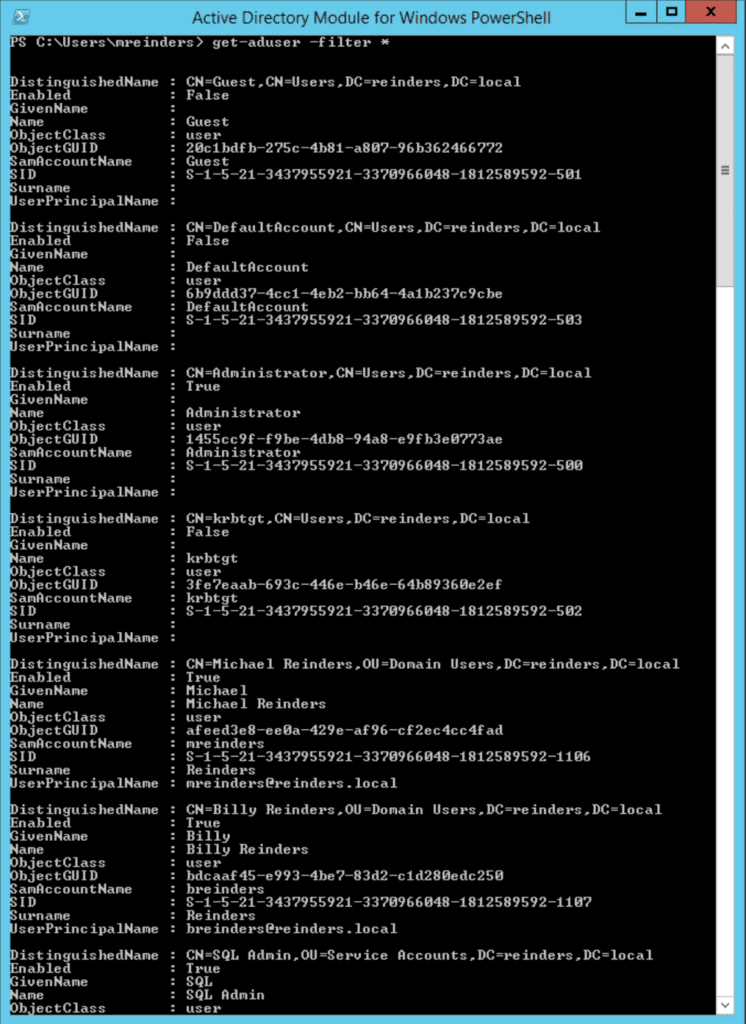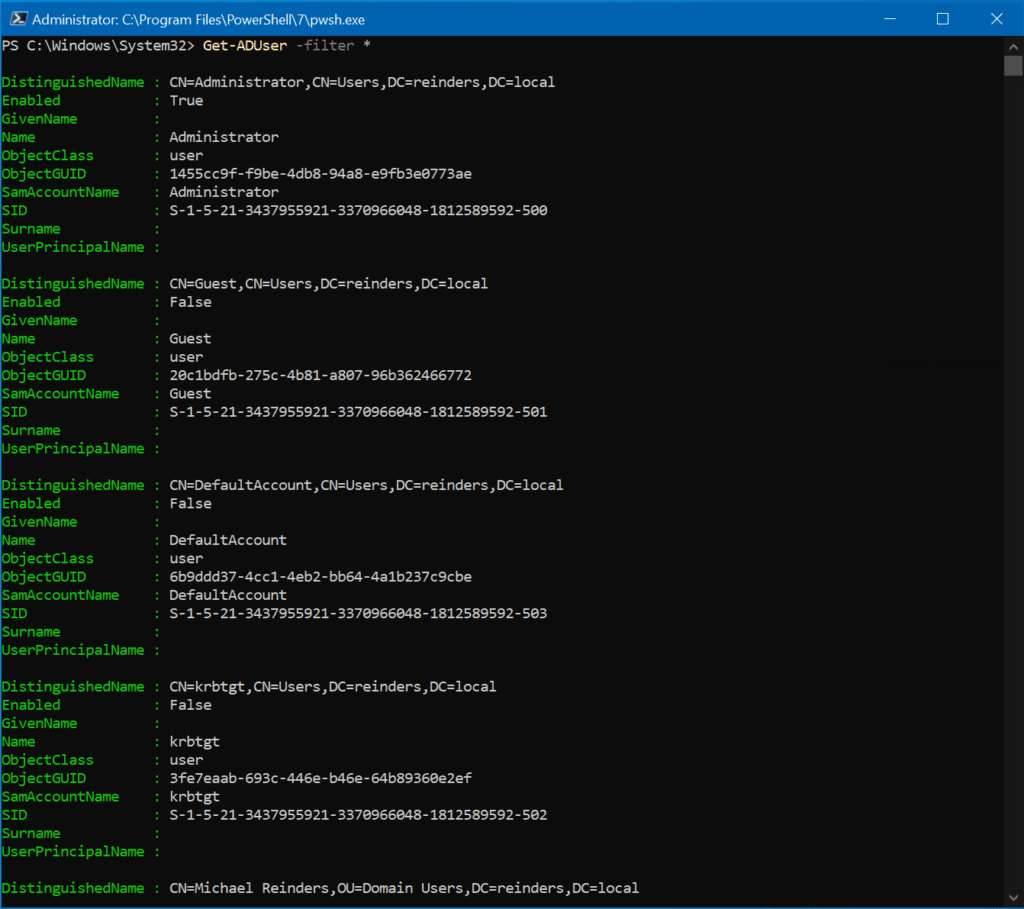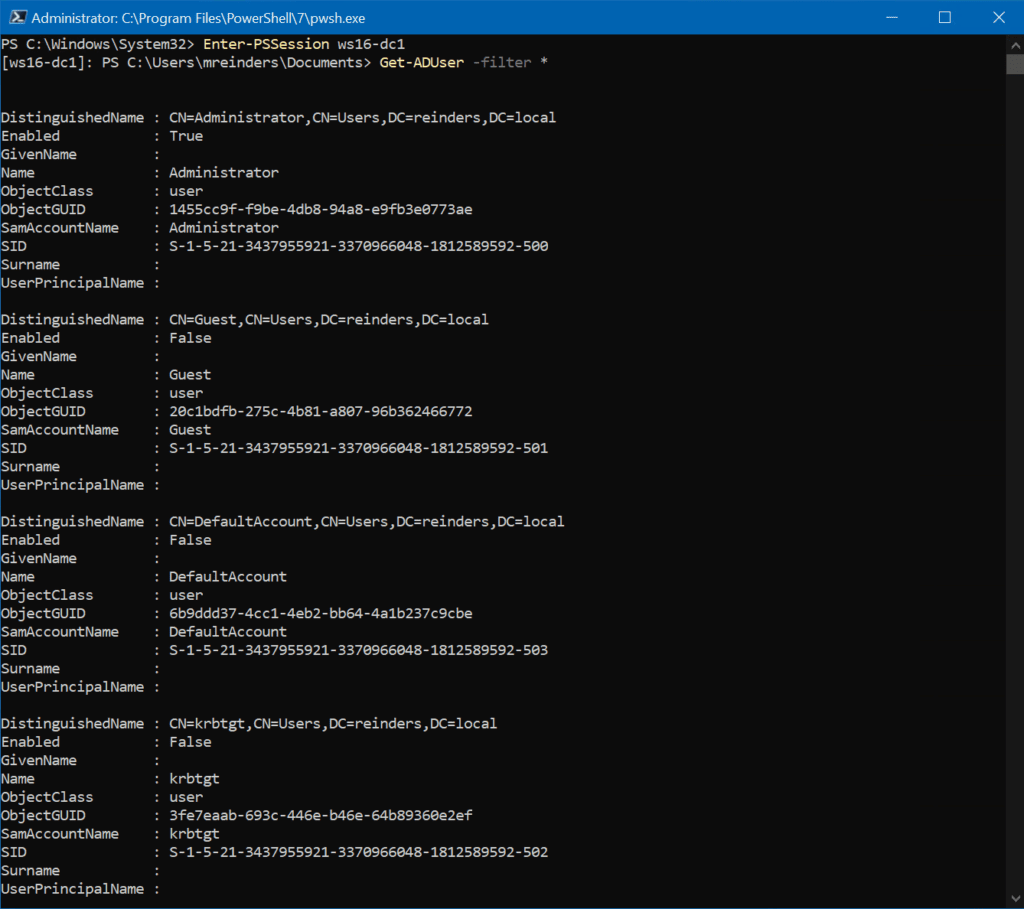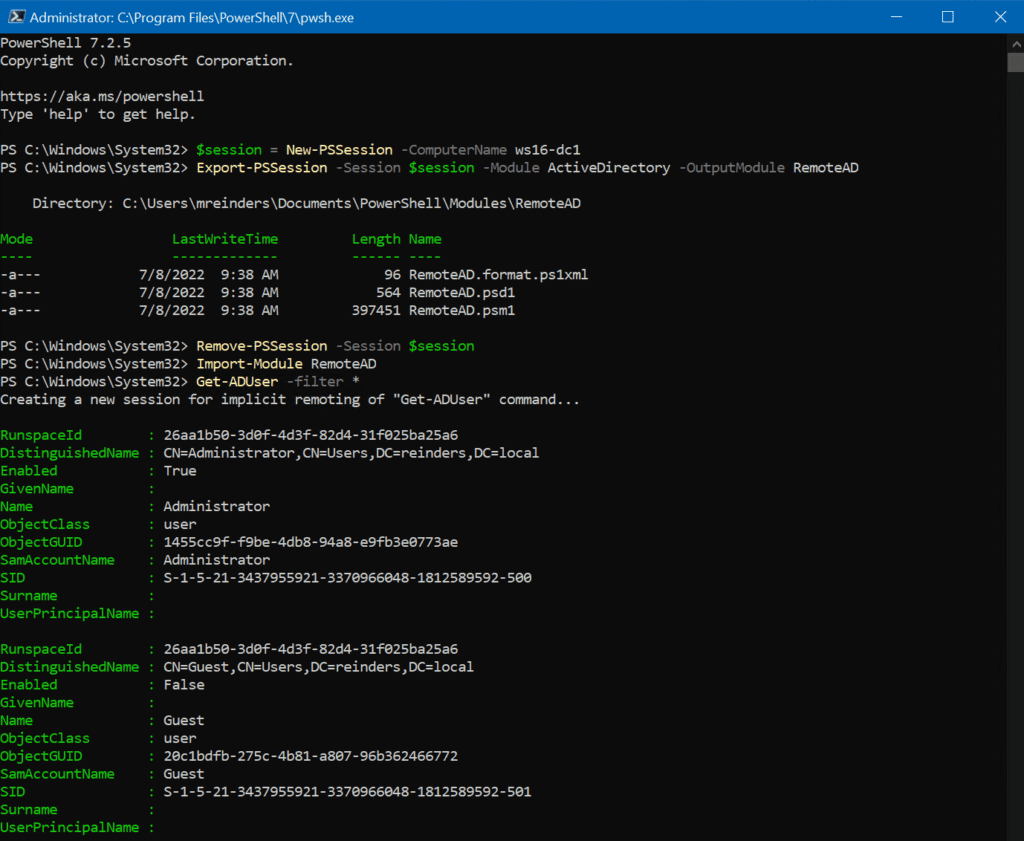Любой системный администратор Windows должен уметь пользоваться не только графическими оснастками AD (чаще всего это ADUC – Active Directory Users and Computer), но и командлетами PowerShell для выполнения повседневных задач администрирования Active Directory. Чаще всего для администрирования домена, управления объектами (пользователями, компьютерами, группами) используется модуль Active Directory для Windows PowerShell. В этой статье мы рассмотрим, как установить модуль RSAT-AD-PowerShell, его базовый функционал и популярные командлеты, которые должны быть полезными при управлении и работе с AD.
Содержание:
- Как установить модуль Active Directory для PowerShell в Windows 10 и 11?
- Установка модуля RSAT-AD-PowerShell в Windows Server
- Основные командлеты модуля Active Directory для PowerShell
- Импорт модуля Active Directory PowerShell с удаленного компьютера
- Администрирование AD с помощью модуля Active Directory для PowerShell
Как установить модуль Active Directory для PowerShell в Windows 10 и 11?
Вы можете установить модуль RSAT-AD-PowerShell не только на серверах, но и на рабочих станциях. Этот модуль входит в состав пакета RSAT (Remote Server Administration Tools) для Windows.
В современных билдах Windows 11 и Windows 10 компоненты RSAT устанавливаются онлайн в виде Features on Demand. Вы можете установить модуль с помощью команды:
Add-WindowsCapability -online -Name Rsat.ActiveDirectory.DS-LDS.Tools~~~~0.0.1.0
Или через панель Settings -> Apps -> Optional features -> Add a feature -> RSAT: Active Directory Domain Services and Lightweight Directory Services Tools.
Для предыдущих версий Windows пакет RSAT нужно было качать и устанавливать вручную. После этого нужно активировать модуль AD для PowerShell из панели управления (Control Panel -> Programs and Features -> Turn Windows features on or off -> Remote Server Administration Tools-> Role Administration Tools -> AD DS and AD LDS Tools).
Для использования командлетов AD в PowerShell Core 6.x, 7.x сначала нужно установить модуль WindowsCompatibility:
Install-Module -Name WindowsCompatibility
Затем загрузите модуль в сессию с помощью команд:
Import-Module -Name WindowsCompatibility
Import-WinModule -Name ActiveDirectory
Теперь вы можете использовать командлеты AD в ваших скриптах на PowerShell Core 7.
Установка модуля RSAT-AD-PowerShell в Windows Server
В Windows Server вы можете установить модуль Active Directory для Windows PowerShell из графической консоли Server Manager или с помощью PowerShell.
Вы можете проверить, что модуль Active Directory установлен с помощью команды:
Get-WindowsFeature -Name «RSAT-AD-PowerShell»
Если модуль отсутствует, установите его:
Install-WindowsFeature -Name "RSAT-AD-PowerShell" –IncludeAllSubFeature
Для установки модуля через панель управления Server Manager, перейдите в Add Roles and Features -> Features -> Remote Server Administration tools -> Role Administration Tools -> AD DS and AD LDS Tools -> выберите Active Directory module for Windows PowerShell.
Не обязательно использовать контроллер домена для администрирования Active Directory с помощью модуля RSAT-AD-PowerShell. Этот модуль можно установить на любом сервере или рабочей станции. На контроллерах домена AD модуль устанавливается автоматически при развертывании роли ADDS (при повышении сервера до DC).
Модуль взаимодействует с AD через службу Active Directory Web Services, которая должна быть запущена на контроллере домена и доступна клиентам по порту TCP 9389. Проверьте, что порт доступен на DC с помощью командлета Test-NetConnection:
tnc MSK-DC01 -port 9389
Основные командлеты модуля Active Directory для PowerShell
В модуле Active Directory для Windows PowerShell имеется большое командлетов для взаимодействия с AD. В текущей версии модуля для Windows Server 2022/Windows 11 доступно 147 PowerShell командлетов для AD.
Проверьте, что модуль установлен на компьютере:
Get-Module -Name ActiveDirectory –ListAvailable
Перед использованием командлетов модуля, его нужно импортировать в сессию PowerShell (начиная с Windows Server 2012 R2/ Windows 8.1 и выше модуль импортируется автоматически):
Import-Module ActiveDirectory
Проверьте, что модуль AD загружен в вашу сессию PowerShell:
Get-Module
Вы можете вывести полный список доступных командлетов с помощью команды:
Get-Command –module activedirectory
Общее количество команд в модуле:
Get-Command –module activedirectory |measure-object
Большинство командлетов модуля RSAT-AD-PowerShell начинаются с префикса Get-, Set-или New-.
- Командлеты класса Get— используются для получения различной информации из AD (Get-ADUser — свойства пользователей, Get-ADComputer – параметры компьютеров, Get-ADGroupMember — состав групп и т.д.). Для их выполнения не нужно быть администратором домена, любой пользователь домена может выполнять скрипты PowerShell для получения значений большинства атрибутов объектов AD (кроме защищенных, как в примере с LAPS).
- Командлеты класса Set— служат для изменения параметров объектов в AD, например, вы можете изменить свойства пользователя (Set-ADUser), компьютера (Set-ADComputer), добавить пользователя в группу и т.д. Для выполнения этих операций у вашей учетной записи должны быть права на объекты, которые вы хотите изменить (см. статью Делегирование прав администратора в AD).
- Команды, начинающиеся с New- позволяют создать объекты AD: создать пользователя — New-ADUser, группу — New-ADGroup, создать Organizational Unit — New-ADOrganizationalUnit.
- Командлеты, начинающиеся с Add—: добавить пользователю в группу (Add-ADGroupMember), создать гранулированные политики паролей (Add-ADFineGrainedPasswordPolicySubject);
- Командлеты Remove— служат для удаления объектов AD (Remove-ADGroup, Remove-ADComputer, Remove-ADUser).
Есть специфические командлеты PowerShell для управления только определенными компонентами AD:
-
Enable-ADOptionalFeature
– включить компоненты AD (например, корзину AD для восстановления удаленных объектов) -
Install-ADServiceAccount
– настроить учетную запись для службы (MSA, gMSA) -
Search-ADAccount
– позволяет найти в AD отключенные, неактивные, заблокированные учетные записи пользователей и компьютеров -
Enable-ADAccount
/
Disable-ADAccount
/
Unlock-ADAccount
– включить/отключить/ разблокировать учетную запись
По умолчанию командлеты PowerShell подключаются к вашему ближайшему контроллеру в вашем домене (LOGONSERVER). С помощью параметра -Server вы можете подключиться к ADDS на другом контроллере домена или в другом домене (список DC в другом домене можно вывести с помощью команды
nltest /dclist:newdomain.com
). Параметр -Server доступен почти для всех командлетов модуля. Например:
Get-ADuser aaivanov -Server msk-dc01.winitpro.ru
Также вы можете указать учетную запись для подключения к AD с помощью параметра -Credential.
$
creds = Get-Credential
Get-ADUser -Filter * -Credential $creds
Получить справку о любом командлете можно так:
get-help New-ADComputer
Примеры использования командлетов Active Directory можно вывести так:
(get-help Set-ADUser).examples
В PowerShell ISE при наборе параметров командлетов модуля удобно использовать всплывающие подсказки.
Импорт модуля Active Directory PowerShell с удаленного компьютера
Не обязательно устанавливать модуль AD PowerShell на все компьютеры. Администраора может удаленно импортировать это модуль с контроллера домена (нужны права администратора домена) или с любого другого компьютера.
Для подключения к удаленном компьютеру исопьзуется PowerShell Remoting. Это требует, чтобы на удаленном компьютере был включен и настроен Windows Remote Management (WinRM).
Создайте новую сесиию с удаленнм компьютером, на котором установлен модуль AD PowerShell:
$rs = New-PSSession -ComputerName DC_or_Comp_with_ADPosh
Импортируйте модуль ActiveDirectory с удаленного компьютера в вашу локальную сессию:
Import-Module -PSsession $rs -Name ActiveDirectory
Теперь вы можете выполнять любые команды из модуля Active Directory на своем компьютере, как будто это модуль установлен локально. При этом они выполняются на удаленном хосте.
Вы можете добавить эти команды в ваш файл профиля PowerShell (например,
notepad $profile.CurrentUserAllHosts
), чтобы автоматически импортировать модуль из удаленной сессии при запуске консоли powershell.exe.
Завершить удалённую сессию можно командой:
Remove-PSSession -Session $rs
Этот же способ с импортом модуля AD через PoweShell implicit remoting позволит вам использовать командлеты PowerShell с хостов Linux and macOS, на которые нельзя установить локальную копию модуля.
Также вы можете использовать модуль Active Directory для PowerShell без установки RSAT. Для этого достаточно скопировать с компьютера с установленным модулем RSAT-AD-PowerShell:
- Каталог C:WindowsSystem32WindowsPowerShellv1.0Modules
- Файл ActiveDirectory.Management.dll
- Файл ActiveDirectory.Management.resources.dll
Затем нужно импортировать модуль в сессию:
Import-Module C:pathMicrosoft.ActiveDirectory.Management.dll
Import-Module C:pathMicrosoft.ActiveDirectory.Management.resources.dll
После этого вы можете использовать все командлеты из модуля AD без установки RSAT.
Администрирование AD с помощью модуля Active Directory для PowerShell
Рассмотрим несколько типовых задач администратора, которые можно выполнить с помощью команд модуля AD для PowerShell.
Полезные примеры использования различных командлетов модуля AD для PowerShell уже описаны на сайте. Следуйте ссылкам по тексту за подробными инструкциями.
New-ADUser: Создать пользователя в AD
Для создания нового пользователя в AD используется использовать командлет New-ADUser. Создать пользователя можно командой:
New-ADUser -Name "Andrey Petrov" -GivenName "Andrey" -Surname "Petrov" -SamAccountName "apetrov" -UserPrincipalName "[email protected] " -Path "OU=Users,OU=Ufa,DC=winitpro,DC=loc" -AccountPassword(Read-Host -AsSecureString "Input Password") -Enabled $true
Более подробно о команде New-ADUser (в том числе пример массового создания учетных записей в домене) читайте в статье .
Get-ADComputer: Получить информацию о компьютерах домена
Чтобы вывести информацию о компьютерах в определённом OU (имя компьютера и дата последней регистрации в сети) используйте командлет Get-ADComputer:
Get-ADComputer -SearchBase ‘OU=Russia,DC=winitpro,DC=ru’ -Filter * -Properties * | FT Name, LastLogonDate -Autosize
Add-AdGroupMember: Добавить пользователя в группу AD
Чтобы добавить пользователей в существующую группу безопасности в домене AD, выполните команду:
Add-AdGroupMember -Identity MskSales -Members apterov, divanov
Вывести список пользователей в группе AD и выгрузить его в файл:
Get-ADGroupMember MskSales -recursive| ft samaccountname| Out-File c:scriptexport_users.csv
Более подробно об управлении группами AD из PowerShell.
Set-ADAccountPassword: Сброс пароля пользователя в AD
Чтобы сбросить пароль пользователя в AD из PowerShell, выполните:
Set-ADAccountPassword apterov -Reset -NewPassword (ConvertTo-SecureString -AsPlainText “[email protected]” -Force -Verbose) –PassThru
Блокировка/разблокировка пользователя
Отключить учетную запись:
Disable-ADAccount apterov
Включить учетную запись:
Enable-ADAccount apterov
Разблокировать аккаунт после блокировки парольной политикой:
Unlock-ADAccount apterov
Search-ADAccount: Поиск неактивных компьютеров в домене
Чтобы найти и заблокировать в домене все компьютеры, которые не регистрировались в сети более 100 дней, воспользуйтесь командлетом Search-ADAccount:
$timespan = New-Timespan –Days 100
Search-ADAccount -AccountInactive -ComputersOnly –TimeSpan $timespan | Disable-ADAccount
New-ADOrganizationalUnit: Создать структуру OU в AD
Чтобы быстро создать типовую структуры Organizational Unit в AD, можно воспользоваться скриптом PowerShell. Допустим, нам нужно создать несколько OU с городами, в которых создать типовые контейнеры. Вручную через графическую консоль ADUC такую структуру создавать довольно долго, а модуль AD для PowerShell позволяет решить такую задачу за несколько секунд (не считая время на написание скрипта):
$fqdn = Get-ADDomain
$fulldomain = $fqdn.DNSRoot
$domain = $fulldomain.split(".")
$Dom = $domain[0]
$Ext = $domain[1]
$Sites = ("SPB","MSK","Sochi")
$Services = ("Users","Admins","Computers","Servers","Contacts")
$FirstOU ="Russia"
New-ADOrganizationalUnit -Name $FirstOU -Description $FirstOU -Path "DC=$Dom,DC=$EXT" -ProtectedFromAccidentalDeletion $false
foreach ($S in $Sites)
{
New-ADOrganizationalUnit -Name $S -Description "$S" -Path "OU=$FirstOU,DC=$Dom,DC=$EXT" -ProtectedFromAccidentalDeletion $false
foreach ($Serv in $Services)
{
New-ADOrganizationalUnit -Name $Serv -Description "$S $Serv" -Path "OU=$S,OU=$FirstOU,DC=$Dom,DC=$EXT" -ProtectedFromAccidentalDeletion $false
}
}
После выполнения скрипта у нас в AD появилась такая структура OU.
Для переноса объектов между контейнерами AD можно использовать командлет Move-ADObject:
$TargetOU = "OU=Buhgalteriya,OU=Computers,DC=corp,DC=winitpro,DC=ru"
Get-ADComputer -Filter 'Name -like "BuhPC*"' | Move-ADObject -TargetPath $TargetOU
Get-ADReplicationFailure: Проверка репликации в AD
С помощью командлета Get-ADReplicationFailure можно проверить состояние репликации между контроллерами домена AD:
Get-ADReplicationFailure -Target DC01,DC02
Получить информацию обо всех DC в домене с помощью командлета Get-AdDomainController:
Get-ADDomainController –filter * | select hostname,IPv4Address,IsGlobalCatalog,IsReadOnly,OperatingSystem | format-table –auto
В этой статье мы рассмотрели, как установить и использовать модулья AD PowerShell для администрирования домена. Надеюсь, эта статья подтолкнет вас к дальнейшему исследованию возможностей этого модуля и автоматизации большинства задач управления AD.
Сегодня я покажу, как установить и использовать модуль администрирования Active Directory для Windows PowerShell. Командлеты этого модуля можно использовать для получения информации и управлением различными объектами и параметрами AD. Данный модуль в серверных ОС устанавливается в виде отдельного компонента. На десктопные ОС (Windows 10, 8.1, 7) придется установить пакет Remote Server Administration Tools (RSAT) в состав которого входит модуль для взаимодействия с AD из PowerShell. Кроме этого модуля в состав RSAT входят все необходимые графические оснастки управления, утилиты командной строки и модули Windows PowerShell для администрирования Windows и AD. Данный пакет для вашей версии ОС нужно самостоятельно скачать с сайта Microsoft.
- Установка модуля Active Directory для Windows PowerShell
- Импорт и использование модуля PowerShell для Active Directory
Содержание:
Установка модуля Active Directory для Windows PowerShell
Модуль Active Directory для Windows PowerShell впервые появился в Windows Server 2008 R2. Он автоматически устанавливается на контроллерах домена при их установке на них роли ADDS. Для использования комадлетов PowerShell из модуля AD в домене должен быть хотя бы один контроллер с Windows Server 2008 R2 или выше. Если в вашей сети имеются DC только с Windows Server 2003 и 2008, необходимо скачать и установить Active Directory Management Gateway Service. Командлеты PowerShell из модуля Active Directory взаимодействуют с веб-сервисом, который является частью контролера домена с ролью ADDS.
Вы можете установить модуль Active Directory для Windows PowerShell не только на контроллер домена, но и на любой рядовой сервер домена или рабочую станцию. В Windows Server 2016 установить модуль Active Directory для Windows PowerShell можно из графической консоли Server Manager с помощью мастера добавления ролей и компонентов. Достаточно запустить мастер и на этапе выбора компонентов нужно выбрать пункт Средства удаленного администрирования сервера -> Средства администрирования ролей -> Средства AD DS и AD LDS -> Модуль Active Directory для Windows PowerShell (Remote Server Administration Tools > Role Administration Tools > AD DS and AD LDS Tools ->Active Directory module for Windows PowerShell).
Данный модуль можно установит и с помощью PowerShell. Откройте консоль PowerShell с правами администратора и выполните команды:
Import-Module ServerManager
Add-WindowsFeature -Name "RSAT-AD-PowerShell" –IncludeAllSubFeature
В Windows 10, Windows 8.1 и Windows 10 для установки модуля RSAT-AD-PowerShell нужно сначала установить соответствующую версию RSAT, после этого модуль нужно включить в Панели управления (Панель управления -> Программы ->Программы и компоненты и нажмите «Включить компоненты Windows» -> Remote Server Administration Tools -> Role Administration Tools -> AD DS and AD LDS Tools -> включите компонент Active Directory Module for Windows POwerShell.
Либо можно установить модуль с помощью PowerShell:
Enable-WindowsOptionalFeature -Online -FeatureName RSATClient-Roles-AD-Powershell
Импорт и использование модуля PowerShell для Active Directory
В Windows 7 и Windows Server 2008 R2, на которых установлен PowerShell 2.0, чтобы начать пользоваться модулем AD необходимо импортировать его в сессию PowerShell командой:
Import-Module activedirectory
Кроме того, вы можете экспортировать модуль с удаленной машины, где он уже установлен и импортировать его в свою сессию PowerShell:
$MySession = New-PSSession -ComputerName MyDomainController
Export-PSsession -Session $MySession -Module ActiveDirectory -OutputModule RemoteADPosh
Remove-PSSession -Session $MySession
Import-Module RemoteADPosh
В Windows Server 2012 R2/ 2016 и Windows 8.1 / Windows 10 модуль (если он установлен) импортируется в сессию автоматически.
Если компьютер включен в домен, по умолчанию создается диск по имени AD:..Вы можете перейти на этот диск командой CD и использовать привычные команды работы с файловой системой для навигации по этому диску. Пути представлены в формате X500.
PS C:> cd AD:PS AD:> dir
…
PS AD:> cd "DC=vmblog,DC=ru"
Вывести список доступных командлетов модуля для работы с Active Directory можно так:
Get-Command -Module ActiveDirectory
В различных версия Windows доступно разное количество командлетов:
- Windows Server 2008 R2 — 76 командлетов.
- Windows Server 2012 — 135 командлетов
- Windows Server 2012 R2 / 2016 — 147 командлетов.
Итак, теперь вы можете использовать командлеты PowerShell для администрирования AD. На нашем сайты вы можете познакомиться с использованием следующих командлетов из модуля AD для PowerShell: Get-ADGroupMember , Add-ADGroupMember , Move-ADDirectoryServerOperationMasterRole, New-ADGroup.
This guide has been updated for the latest Windows versions Windows 11 and Windows Server 2022. You’ll learn how to install the Active Directory (AD) module for PowerShell Core 6.0, PowerShell 7 and Windows PowerShell. For Windows PowerShell, the tutorial describes how to install the AD module for Windows 7, Windows 8, Windows 8.1, Windows 10, Windows 11 Windows Server 2008 R2, Windows Server 2012 R2, and Windows Server 2016, Windows Server 2010 and Windows Server 2022. You’ll also learn how to work with the AD module on other systems such as macOS or Linux with the help of PowerShell remoting.
Contents
- Windows 7
- Windows Server 2008 R2
- Windows 8, Windows 8.1
- Windows 10
- Windows 11
- On Windows 11 with PowerShell
- Windows Server 2012, Windows Server 2012 R2, Windows Server 2016, Windows Server 2019, Windows Server 2022
- Install the AD module on PowerShell Core 6.x on a Windows computer
- Use the Active Directory module on Linux and macOS
- All versions: Import the ActiveDirectory module remotely
- Create an interactive remote session
- Import the AD module from a remote session
- Export the remote AD module to a local module
- PowerShell Core and Windows PowerShell modules
- Conclusion
- Author
- Recent Posts
Michael Pietroforte is the founder and editor in chief of 4sysops. He has more than 35 years of experience in IT management and system administration.
Also read: How to install the PowerShell 7 Active Directory module.
The installation of the AD module varies significantly for the different Windows and PowerShell versions. At the time of this writing, the AD module that comes with RAST does not work with PowerShell Core 6.0. However, this guide explains how you can manage Active Directory from PowerShell Core even on macOS and Linux.
Windows 7
On a Windows 7 computer, you can follow this procedure to install the Active Directory module:
- Download the Remote Server Administration Tools (RSAT) for Windows 7.
- Open the Control Panel, start typing features, and then click Turn Windows features on or off.
- Scroll down to Remote Server Administration Tools and enable the Active Directory Module for Windows PowerShell in Remote Server Administration Tools > Role Administration Tools > AD DS and AD LDS Tools.
- Run Import-Module ActiveDirectory on a PowerShell console.
Active Directory Module for Windows PowerShell on Windows 7
If the Windows 7 machine only has PowerShell 2.0 installed, you have to add the Import-Module ActiveDirectory command to your profile because PowerShell doesn’t load modules automatically. For instance, you can import the module in %UserProfile%My DocumentsWindowsPowerShellprofile.ps1. Makes sure you’ve set your execution policy to either RemoteSigned or Unrestricted: Set-ExecutionPolicy RemoteSigned.
Another option is to open the module from the Administrative Tools folder in the Control Panel.
Active Directory Module in Administrative Tools
Windows Server 2008 R2
If your Windows Server 2008 R2 machine is a domain controller, the PowerShell Active Directory Module is already installed. You only have to install the module on member servers. The procedure on Windows Server 2008 R2 is similar to that on Windows 7. (Note that the module is not available for Windows Server 2008.)
One difference is that you don’t have to download RSAT because the tools are already available on Windows Server 2008 R2.
- In Server Manager, click Add features, and then:
- Select Active Directory module for Windows PowerShell in Remote Server Administration Tools > Role Administration Tools > AD DS and AD LDS Tools.
Alternatively, you can install the module from a PowerShell console:
Import-Module ServerManagerAdd-WindowsFeature RSAT-AD-PowerShell
After copying the module to your computer, you have to import it:
Import-Module ActiveDirectory
Or you can right-click the PowerShell icon on the taskbar and select Import system modules.
Import system modules
As on Windows 7, if you want to make the import permanent, you have to add the above import command to your PowerShell profile. Notice this description assumes you haven’t updated PowerShell 2 on your Windows Server 2008 R2 machine (see the description about Windows 7).
Windows 8, Windows 8.1
Things are a lot easier in Windows 8, Windows 8.1, and Windows 10. All you have to do is download and install RSAT (Windows 8, Windows 8.1, Windows 10). The installation enables all tools by default, and you also don’t have to import the module. You can use the AD module right away after you install RSAT.
Windows 10
Since Windows 10, the RSAT tools were shifted from being a standalone package to being a feature on demand in Windows 10. Click the menu and then search for «features» and then navigate to App and Features > Optional Features > Add a feature. Type RSAT in the search field and select the second option—RSAT: Active Directory Domain Services and Lightweight Directory Services Tools.
Install the AD module in Windows 10
Windows 11
In Windows 11, click the Start, type «Settings» in the Search field.
Apps in Windows 11
Now click Apps > Optional Features > View features.
Optinal Features in Windows 11
Add an optional feature in Windows 11
Then type «RSAT» and select RSAT: Active Directory Domain Services and Lightweight Directory Services Tools and click Next and then Install.
Install RSAT on Windows 11
To verify that RSAT has been installed launch a PowerShell console with Administrator privileges and then type this command:
Get-WindowsCapability -Name RSAT* -Online | Select-Object -Property DisplayName, State
Verfiying that RSAT is installed with PowerShell
On Windows 11 with PowerShell
If you don’t want to avoid all this clicking you can install all the RSAT tools in one go with this PowerShell command below. Make sure that you are working on an elevated PowerShell console.
Get-WindowsCapability -Name RSAT* -Online | Add-WindowsCapability -Online
Intstall RSAT with PowerShell
Windows Server 2012, Windows Server 2012 R2, Windows Server 2016, Windows Server 2019, Windows Server 2022
As on Windows Server 2008 R2, the AD module is already installed on domain controllers on Windows Server 2012, Windows Server 2012 R2, and Windows Server 2016. On member servers, you can add the module as a feature in Server Manager.
- Start Server Manager.
- Click Manage > Add Roles and Features.
- Click Next until you reach Features.
- Enable Active Directory module for Windows PowerShell in Remote Server Administration Tools > Role Administration Tools > AD DS and AD LDS Tools.
Install the AD module on Windows Server 2016
Alternatively, you can install the module from a PowerShell console:
Install-WindowsFeature RSAT-AD-PowerShell
Installing the AD module on Windows Server 2012 with PowerShell
There’s no need to import the Server Manager module first, as on Windows Server 2008 R2. You also don’t have to import the AD module after the installation.
If you want to verify the successful installation of the module, you can just run the Get-ADuser cmdlet.
Install the AD module on PowerShell Core 6.x on a Windows computer
- Install RSAT with the method matching to your operating system (see sections above).
- Install the WindowsCompatibility module.
Install-Module -Name WindowsCompatibility
- Load the WindowsCompatibility module like usual with the Import-Module cmdlet
Import-Module -Name WindowsCompatibility
- Load the ActiveDirectory module with the Import-WinModule cmdlet
Import-WinModule -Name ActiveDirectory
Use the Active Directory module on Linux and macOS
On Linux and macOS you can’t install Active Directory module. However, you use PowerShell remoting to connect to a Windows server with Active Directory and then work with the AD module in remoting session. Read ahead to learn how to use remoting with the AD module.
All versions: Import the ActiveDirectory module remotely
Create an interactive remote session
The simplest option is to create an interactive remote session to your domain controller with the Enter-PSsession cmdlet:
Enter-PSsession MyDomainConroller
You can then work right away with the AD cmdlets. This option is good if you only occasionally manage AD on a PowerShell console and if you don’t have to execute local scripts.
Managing Active Directory on PowerShell Core in an interactive remote session
Import the AD module from a remote session
The second option uses implicit remoting and allows you to run the AD cmdlets from a local session. However, you execute the AD cmdlets remotely on a domain controller. In practice, you won’t notice much of difference in locally installed cmdlets. To import the AD module on PowerShell Core 6.0, execute these commands:
$S = New-PSSession -ComputerName MyDomainConroller Import-Module -PSsession $S -Name ActiveDirectory
Import the AD module on PowerShell Core 6.0
The first command creates a PowerShell session (PSsession) on the domain controller (replace MyDomainController with the name of your DC) and establishes a persistent connection. Next, we import the ActiveDirectory module from this remote PSsession into our local session.
You can now use all AD module cmdlets on your local PowerShell Core console. Just keep in mind the commands always execute remotely.
If you often work with AD, you can add the above commands to your profile, for instance in DocumentsPowerShellProfile.ps1.
Export the remote AD module to a local module
Alternatively, you can export the AD cmdlets from a remote session to a local module:
$S = New-PSSession -ComputerName MyDomainController Export-PSsession -Session $S -Module ActiveDirectory -OutputModule RemoteAD Remove-PSSession -Session $S Import-Module RemoteAD
Exporting the Active Directory module to a local module
These commands will create a local module in your Documents folder under PowerShellModulesRemoteAD. However, like with the above solution, you will be working with implicit remoting, and all cmdlets will execute remotely. The local RemoteAD module only links to the cmdlets on the domain controller. If you want to use the RemoteAD module on other machines with PowerShell Core, simply copy the RemoteAD folder to the PowerShell Core module folder on the second machine.
The difference with the «import solution» is that in the «export solution,» PowerShell only establishes a connection to the domain controller when you use an AD cmdlet the first time. You also don’t have to add the above commands to your profile because PowerShell will load the local RemoteAD module automatically. However, the downside to this option is you might have to repeat the procedure after updating the AD module on the domain controller.
PowerShell Core and Windows PowerShell modules
Note that you can use Windows PowerShell together with PowerShell Core on the same machine and work with the different AD modules in both shells. If you installed RSAT, the AD module for Windows PowerShell will reside in this folder:
$env:windir/System32/WindowsPowerShell/v1.0/Modules/ActiveDirectory
If you used the export solution, the RemoteAD module will be in this folder:
$env:userprofile/Documents/PowerShell/Modules/RemoteAD
PowerShell Core and Windows PowerShell use different folders
PowerShell Core does not import modules in WindowsPowerShell folders, and Windows PowerShell does not load PowerShell Core modules, which are always in PowerShell folders. Thus, you don’t have to worry about conflicts between the different AD modules in PowerShell Core and Windows PowerShell.
Conclusion
Using the Active Directory module has become simpler with each PowerShell version up to Microsoft’s release of PowerShell Core 6.0. However, working with implicit remoting and remote sessions has various advantages. One advantage is that you can use disconnected remote sessions. This allows you to start a script, shut down your client computer, and retrieve the results from the remote machine later. If you often work with remote sessions, you should become familiar with the different ways you can use PowerShell remote sessions. Once you get used to working with remoting, you probably won’t miss the local AD module for PowerShell Core.
Модуль Active Directory для Windows PowerShell — один из основных инструментов для администрирования домена, управления объектами в Active Directory и получения различной информации о компьютерах AD, пользователях, группах и т. д. Любой администратор Windows должен знать, как использовать как графическую оснастку AD (обычно это ADUC — Active Directory Users & Computers) и командлеты модуля RSAT-AD-PowerShell для выполнения повседневных задач администрирования Active Directory. В этой статье мы рассмотрим, как установить модуль PowerShell Active Directory в Windows, познакомимся с его основными функциями и популярными командлетами, которые полезны для управления и взаимодействия с AD.
Установка модуля Powershell Active Directory на Windows Server
Active Directory для Windows PowerShell уже встроен в операционные системы Windows Server (начиная с Windows Server 2008 R2), но по умолчанию не включен.
В Windows Server 2016, 2019 и 2022 вы можете установить модуль AD для PowerShell из Диспетчера серверов (Добавить роли и компоненты → Функции → Инструменты удалённого администрирования сервера → Инструменты администрирования ролей → Инструменты AD DS и AD LDS → Модуль Active Directory для Windows PowerShell).
В англоязычной версии сервера это соответственно в Server Manager: Add Roles and Features → Features → Remote Server Administration Tools → Role Administration Tools → AD DS and AD LDS Tools → Active Directory module for Windows PowerShell.

Если вы уже установили роль Active Directory Domain Services, то это означает, что модуль Powershell Active Directory уже активирован и дополнительных действий предпринимать не нужно.
Смотрите также: Полное руководство по Active Directory, от установки и настройки до аудита безопасности. Ч. 4: Установка Active Directory Domain Services в Windows Server 2022
Вы также можете установить модуль из консоли PowerShell с помощью команды:
Install-WindowsFeature -Name "RSAT-AD-PowerShell" -IncludeAllSubFeature

Смотрите также: Управление ролями и функциями Windows Server с помощью PowerShell
Вы можете установить RSAT-AD-PowerShell не только на контроллеры домена. Подойдёт любой рядовой сервер домена или даже рабочая станция. Модуль PowerShell Active Directory устанавливается автоматически при развёртывании роли доменных служб Active Directory (AD DS) (при повышении уровня сервера до контроллера домена AD).
Модуль взаимодействует с AD через веб-службу Active Directory, которая должна быть установлена на вашем контроллере домена (связь осуществляется через TCP-порт 9389).
Как установить модуль Active Directory PowerShell в командной строке
Вы можете установить модуль RSAT-AD-PowerShell не только на Windows Server, но и на свои рабочие станции.
Если вы попытаетесь выполнить приведённую выше PowerShell команду:
Install-WindowsFeature -Name "RSAT-AD-PowerShell" -IncludeAllSubFeature
то получите сообщение об ошибке:
Install-WindowsFeature: Целевым объектом указанного командлета не может быть клиентская операционная система Windows.

Причём независимо от того, какая у вас редакция Windows: Home, Pro, Enterprise.
Тем не менее, в Windows 10 build 1809 или новее пакет RSAT интегрирован в образ Windows (как компоненты по запросу), поэтому вы можете использовать эту команду PowerShell для установки модуля Active Directory:
Add-WindowsCapability -online -Name "Rsat.ActiveDirectory.DS-LDS.Tools"

Предыдущую команду нужно выполнять в командной строке с правами администратора.
Связанная статья: Как запустить PowerShell с правами администратора
Как установить модуль Active Directory PowerShell в Windows 11 в графическом интерфейсе
Для установки модуля Active Directory PowerShell в графическом интерфейсе в Windows 11 откройте «Settings» (Параметры), для этого нажмите Win+i и выберите вкладку «Apps» (Приложения), а затем перейдите в «Optional Features» (Дополнительные компоненты).
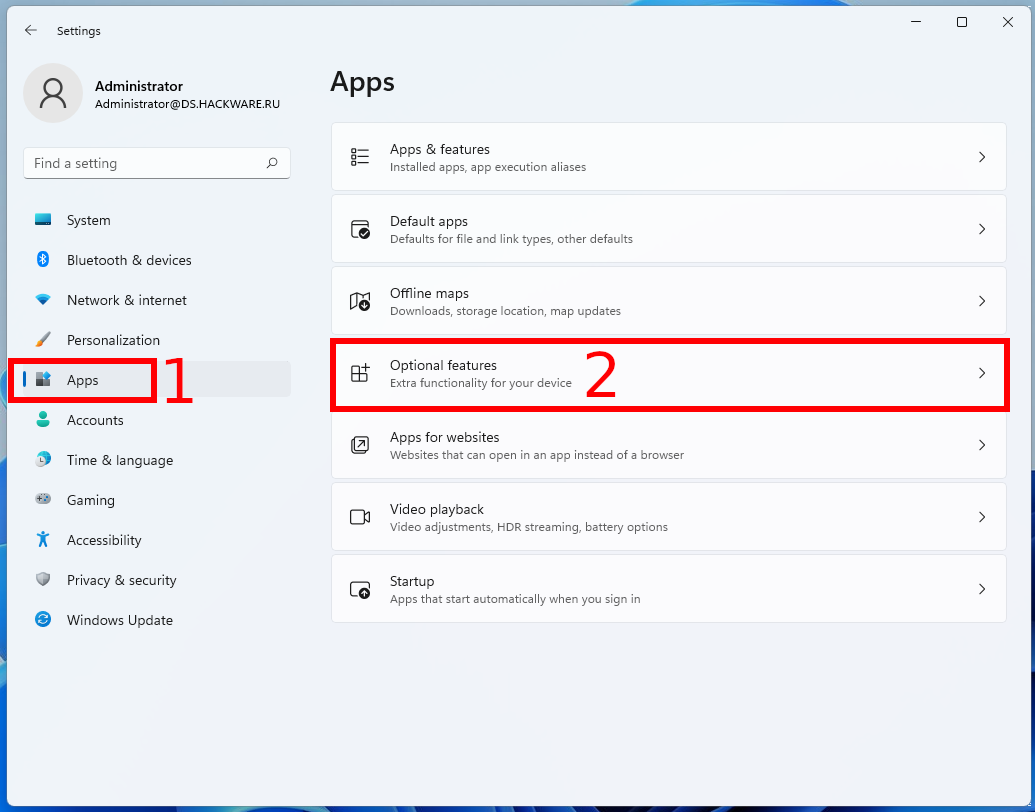
Теперь выберите «View features» (Просмотр компонентов) в строке «Add an optional feature» (Добавить компонент).
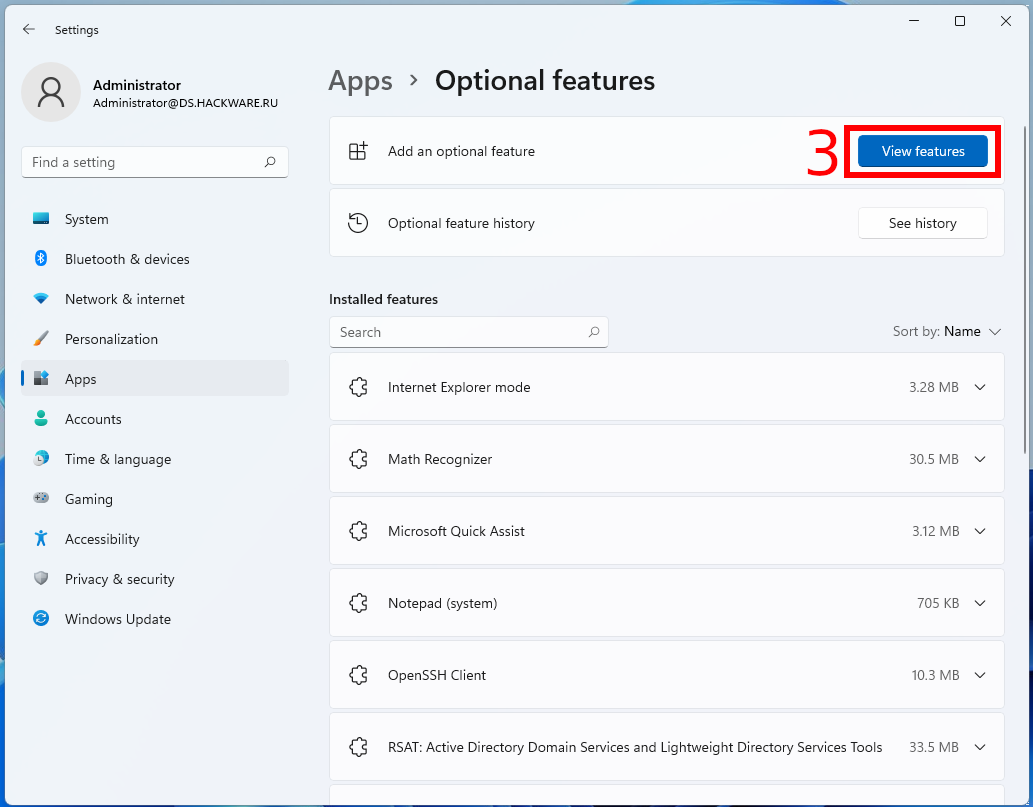
Для установки средств удалённого администрирования Active Directory найдите «RSAT: Active Directory Domain Services and Lightweight Directory Services Tools» (Средства удалённого администрирования сервера: средства доменных служб Active Director и служб облегчённого доступа к каталогам), поставьте галочку и нажмите на кнопку «Next» (Далее),
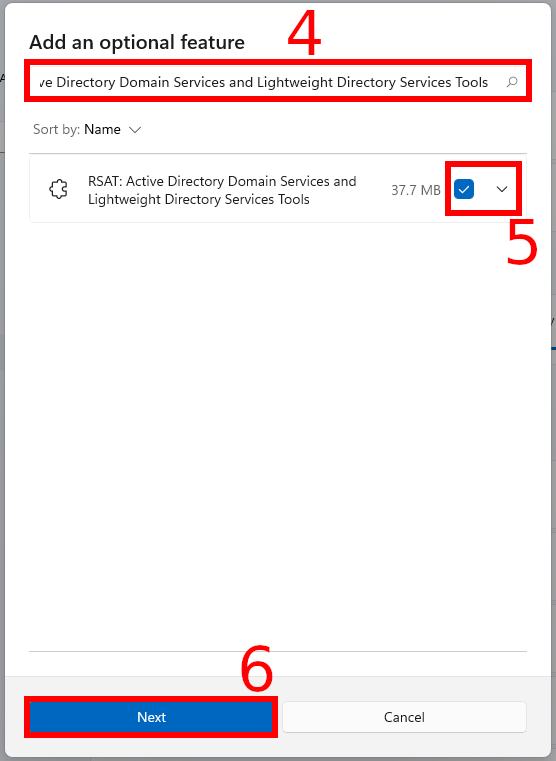
затем нажмите «Install» (Установить).
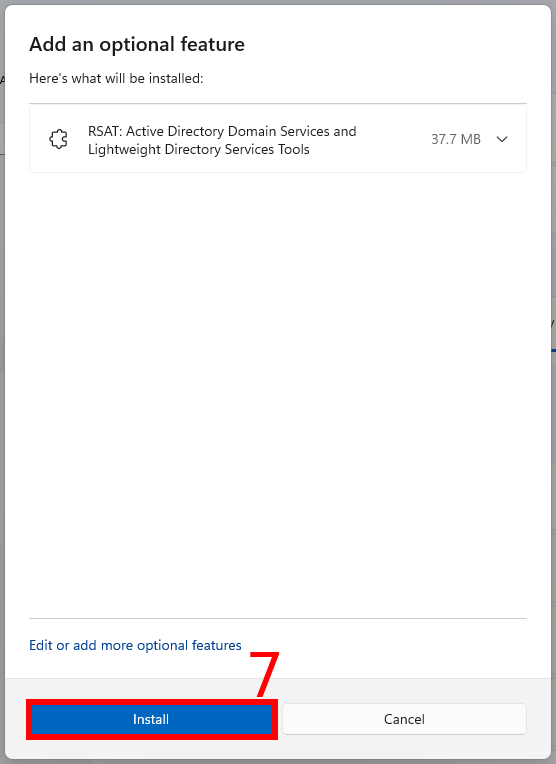
Примечание: если при поиске того или иного компонента вы не можете его найти, то, возможно, данный компонент уже установлен.

Чтобы в этом убедиться в строке поиска под надписью «Installed features» (Установленные компоненты) введите название искомого компонента.
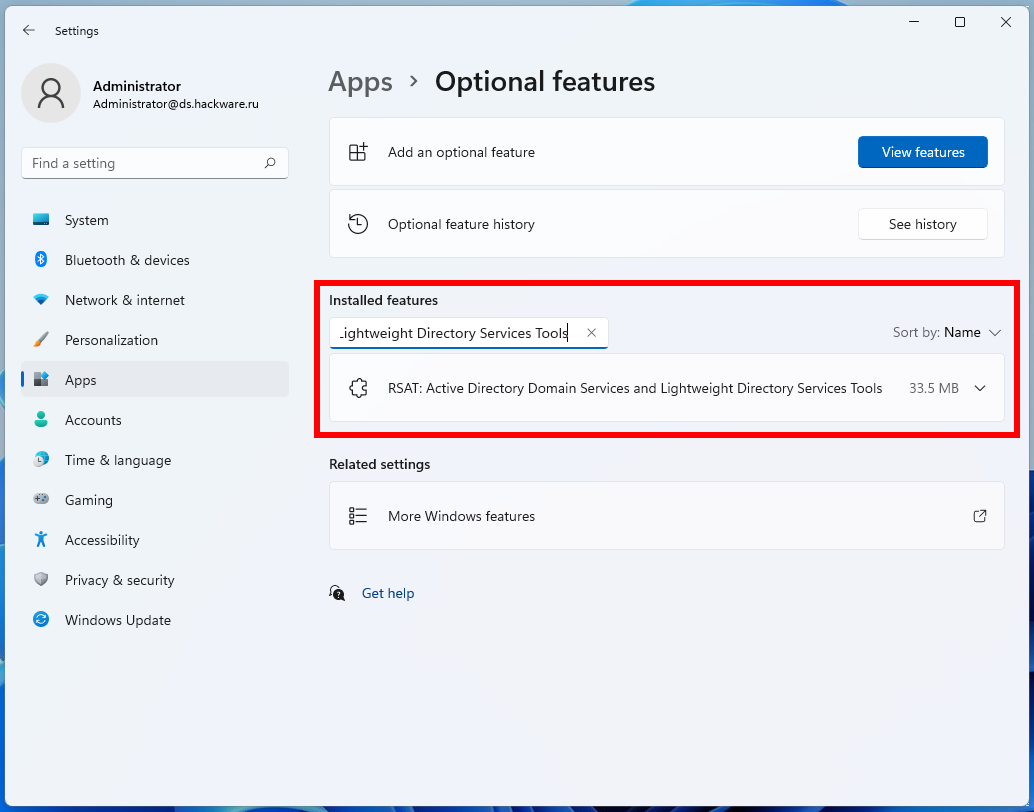
Также помните, что в английской и локализованных версиях Windows данные компоненты называются по-разному!
Как установить модуль Active Directory PowerShell в Windows 10 в графическом интерфейсе
Для установки модуля Active Directory PowerShell в графическом интерфейсе, нажмите Win+x, затем в открывшемся меню выбираем «Apps and Features» (Приложения и возможности).
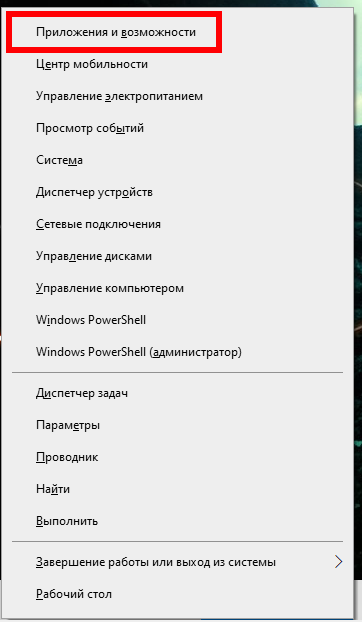
Далее выбираем «Optional Features» (Дополнительные компоненты).

Теперь выбираем «Add a feature» (Добавить компонент).
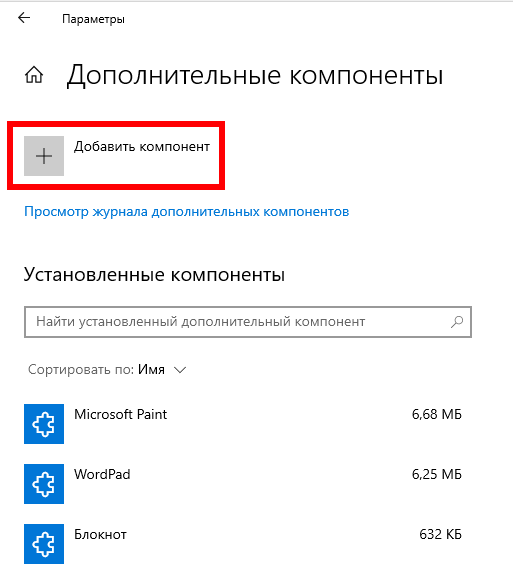
Для установки средств удалённого администрирования Active Directory выбираем «RSAT: Active Directory Domain Services and Lightweight Directory Services Tools» (Средства удалённого администрирования сервера: средства доменных служб Active Director и служб облегчённого доступа к каталогам) и нажимаем на кнопку «Install» (Установить).

Командлеты Active Directory PowerShell
В модуле Active Directory для Windows PowerShell есть множество командлетов для взаимодействия с AD. Каждая новая версия RSAT содержит больше командлетов, чем предыдущая. В Windows Server 2022 доступно 147 командлетов PowerShell для Active Directory.
Перед использованием командлетов модуля Active Directory вам необходимо импортировать его в сеанс PowerShell:
Import-Module ActiveDirectory
Начиная с Windows Server 2012 R2, Windows 8.1 и в последующих версиях модуль импортируется автоматически.
Если модуль Active Directory не установлен на вашем компьютере, вы можете импортировать его со своего контроллера домена (для этого вам нужны права администратора домена) или с другого настольного компьютера:
$psSess = New-PSSession -ComputerName ИМЯ_КОМПЬЮТЕРА Import-Module -PSsession $psSess -Name ActiveDirectory
В этих командах ИМЯ_КОМПЬЮТЕРА — это компьютер, который является Контроллером Домена, либо компьютером, на котором установлен модуль Powershell Active Directory.
Вы можете отобразить полный список доступных командлетов Active Directory с помощью команды:
Get-Command -module ActiveDirectory
Чтобы посчитать общее количество командлетов в модуле AD выполните команду:
Get-Command -module ActiveDirectory | measure-object | select count

Большинство командлетов RSAT-AD-PowerShell начинаются с префиксов Get-, Set- или New-.
- Командлеты Get- класса используются для получения различной информации из Active Directory (Get-ADUser — свойства пользователя, Get-ADComputer — настройки компьютера, Get-ADGroupMember — членство в группе и так далее). Чтобы запустить их, вам не нужно быть администратором домена. Любой пользователь домена может запускать команды PowerShell для получения значений атрибутов объекта AD (кроме конфиденциальных, как в примере с LAPS);
- Командлеты класса Set- используются для установки (изменения) параметров объекта в Active Directory. Например, вы можете изменить свойства пользователя (Set-ADUser), настройки компьютера (Set-ADComputer), добавить пользователя в группу и так далее. Для этого у вашей учётной записи должны быть разрешения на изменение свойств объекта;
- Команды, начинающиеся с New- позволяют создавать объекты AD (создать пользователя – New-ADUser, создать группу – New-ADGroup);
- Командлеты Remove- используются для удаления объектов AD.
Так вы можете получить помощь по любому командлету:
Get-Help КОМАНДЛЕТ Get-Help КОМАНДЛЕТ -Full
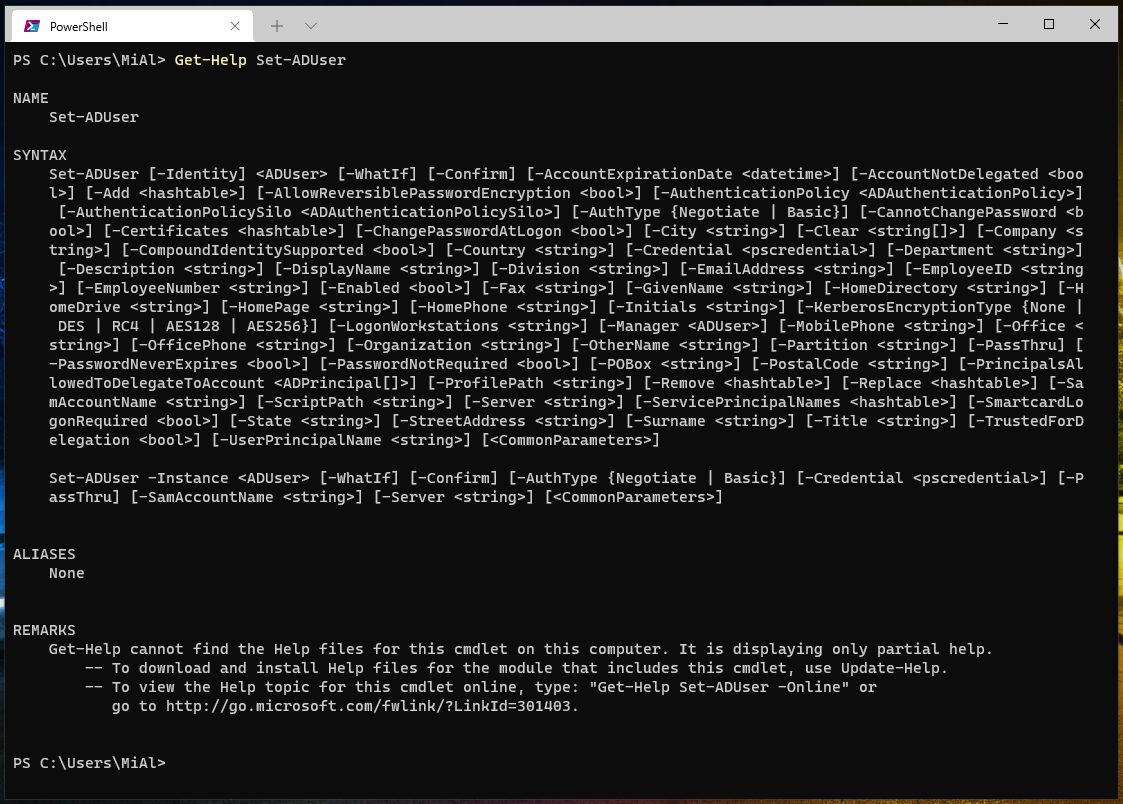
Смотрите также: Как получить справку по командам PowerShell
Вы можете отобразить примеры использования командлетов Active Directory следующим образом:
(Get-Help КОМАНДЛЕТ).examples
Или:
Get-Help КОМАНДЛЕТ -Examples
Всплывающие подсказки удобно использовать при вводе параметров командлета в PowerShell ISE.

Администрирование Active Directory с помощью модуля RSAT-AD-PowerShell
Давайте посмотрим на некоторые типичные задачи администратора, которые вы можете выполнять с помощью командлетов Active Directory для PowerShell.
Вы можете найти больше полезных примеров использования командлетов PowerShell для AD на веб-сайте pwsh.ru. Чтобы получить подробные инструкции и примеры использования, переходите по ссылкам, присутствующим в кратком описании каждого командлета.
New-ADUser: создание пользователей AD
Чтобы создать нового пользователя AD, вы можете использовать командлет New-ADUser. Вы можете создать пользователя с помощью следующей команды:
New-ADUser -Name "Mila Beck" -GivenName "Mila" -Surname "Beck" -SamAccountName "mbeck" -UserPrincipalName "mbeck@hackware.ru" -Path "OU=Users,OU=Berlin,OU=DE,DC=ds,DC=hackware,DC=ru" -AccountPassword(Read-Host -AsSecureString "Input User Password") -Enabled $true
Get-ADComputer: получение свойств компьютера
Чтобы отобразить информацию о свойствах компьютера в конкретном подразделении (имя компьютера и дата последнего входа в систему), используйте командлет Get-ADComputer:
Get-ADComputer -SearchBase 'OU=CA,OU=USA,DC=ds,DC=hackware,DC=ru' -Filter * -Properties * | FT Name, LastLogonDate -Autosize
Смотрите также «Get-ADComputer: поиск сведений о компьютерах и фильтр компьютеров по их свойствам в Active Directory».
Add-AdGroupMember: добавить пользователя AD в группы
Чтобы добавить пользователей в существующую группу безопасности в вашем домене AD, выполните эту команду:
Add-AdGroupMember -Identity LondonSales -Members e.braun, l.wolf
Отобразить список пользователей в группе AD и экспортировать его в файл CSV:
Get-ADGroupMember LondonSales -recursive | ft samaccountname | Out-File c:psexport_ad_users.csv
В предыдущей команде «ft» это командлет Format-Table.
Смотрите также: Управление группами Active Directory с помощью PowerShell
Set-ADAccountPassword: сброс пароля пользователя в AD
Чтобы сбросить пароль пользователя AD из PowerShell, выполните следующую команду:
Set-ADAccountPassword m.lorenz -Reset -NewPassword (ConvertTo-SecureString -AsPlainText "Ne8Pa$$0rd1" -Force -Verbose) -PassThru
Как разблокировать, включить и отключить учётную запись AD?
Чтобы отключить учётную запись пользователя AD:
Disable-ADAccount m.lorenz
Чтобы включить учётную запись:
Enable-ADAccount m.lorenz
Чтобы разблокировать учётную запись после того, как она была заблокирована политикой паролей домена:
Unlock-ADAccount m.lorenz
Search-ADAccount: как найти неактивные и отключённые объекты?
Чтобы найти и отключить все компьютеры в домене AD, которые не входили в систему более 90 дней, используйте командлет Search-ADAccount:
$timespan = New-Timespan -Days 90 Search-ADAccount -AccountInactive -ComputersOnly -TimeSpan $timespan | Disable-ADAccount
New-ADOrganizationalUnit: создание организационной единицы в AD
Чтобы быстро создать типичную структуру организационной единицы в AD, вы можете использовать сценарий PowerShell. Предположим, вы хотите создать несколько подразделений с именами состояний и создать в них типичные контейнеры объектов. Создание этой структуры AD вручную с помощью графической оснастки ADUC занимает довольно много времени. Модуль AD для PowerShell позволяет сделать это за секунды (кроме времени на написание скрипта):
$fqdn = Get-ADDomain
$fulldomain = $fqdn.DNSRoot
$domain = $fulldomain.split(".")
$Dom = $domain[0]
$Ext = $domain[1]
$Sites = ("Nevada","Texas","California","Florida")
$Services = ("Users","Admins","Computers","Servers","Contacts","Service Accounts")
$FirstOU ="USA"
New-ADOrganizationalUnit -Name $FirstOU -Description $FirstOU -Path "DC=$Dom,DC=$EXT" -ProtectedFromAccidentalDeletion $false
ForEach-Object ($S in $Sites)
{
New-ADOrganizationalUnit -Name $S -Description "$S" -Path "OU=$FirstOU,DC=$Dom,DC=$EXT" -ProtectedFromAccidentalDeletion $false
ForEach-Object ($Serv in $Services)
{
New-ADOrganizationalUnit -Name $Serv -Description "$S $Serv" -Path "OU=$S,OU=$FirstOU,DC=$Dom,DC=$EXT" -ProtectedFromAccidentalDeletion $false
}
}
После запуска сценария в Active Directory появляется следующая структура подразделений.
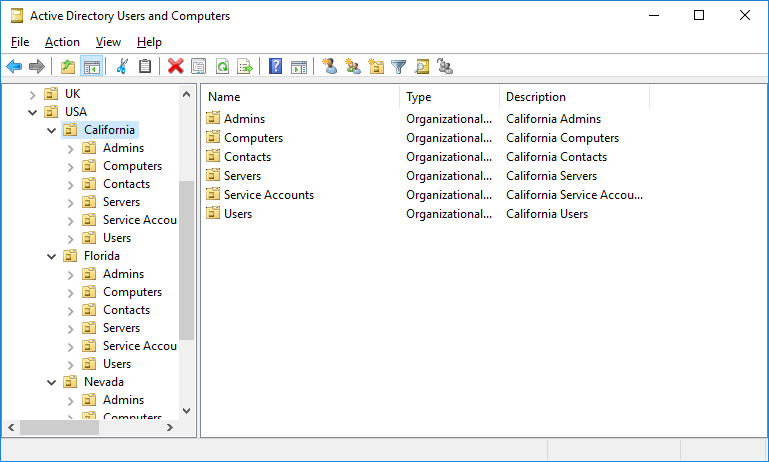
Move-ADObject: перемещение объектов между контейнерами AD
Чтобы перемещать объекты между контейнерами AD, вы можете использовать командлет Move-ADObject:
$TargetOU = "OU=Sales,OU=Computers,DC=ds,DC=hackware,DC=ru" Get-ADComputer -Filter 'Name -like "SalesPC*"' | Move-ADObject -TargetPath $TargetOU
Get-ADReplicationFailure: проверка сбоев репликации AD
Используя командлет Get-ADReplicationFailure, вы можете проверить состояние репликации между контроллерами домена AD:
Get-ADReplicationFailure -Target NY-DC01,NY-DC02
Get-ADDomainController: Получение информации о контроллерах домена
Чтобы получить информацию обо всех контроллерах домена в домене, используйте командлет Get-AdDomainController:
Get-ADDomainController -filter * | select hostname,IPv4Address,IsGlobalCatalog,IsReadOnly,OperatingSystem | format-table -auto

Итак, мы рассмотрели основные возможности модуля Active Directory PowerShell для администрирования домена AD. Я надеюсь, что это побудит вас продолжить изучение других функций модуля и автоматизировать большую часть задач управления AD.
Связанные статьи:
- Как установить Active Directory Domain Services с помощью PowerShell (65.1%)
- Get-ADComputer: поиск сведений о компьютерах и фильтр компьютеров по их свойствам в Active Directory (64.7%)
- Как определить причину блокировки учётной записи в домене Active Directory (63.5%)
- Управление группами Active Directory с помощью PowerShell (60.2%)
- Снижение уровня контроллеров домена в Windows Server в PowerShell и графическом интерфейсе (56.1%)
- Get-ADUser: поиск сведений о пользователях и фильтр пользователей по их свойствам в Active Directory (RANDOM — 53.4%)
A prerequisite for every PowerShell Active Directory (AD) task is to import the PowerShell Active Directory module. This popular module allows administrators to query and make changes to Active Directory with PowerShell.
Discover, report and prevent insecure Active Directory account passwords in your environment with Specops’ completely free Password Auditor Pro. Download it today!
In this blog post, we’re going to dive into how to install the PowerShell Active Directory module on Windows 10. We’ll then cover how to connect to AD with PowerShell and go into the various ways you can authenticate to AD.
Before we begin, you should first be aware of the RSAT package. If you are using a workstation variant of Windows then you will need to install the Remote Server Administration Tools (RSAT) package. When using a Server variant of Windows, RSAT is available already.
Without RSAT you’ll get the annoying ‘the term Get-AD* is not recognized as the name of a cmdlet, function, script file, or operable program’ type messages when you attempt to run the commands we’ll be covering.
RSAT for Pre 1809 Windows 10
Download an RSAT package if you’re on Windows 10 pre-build 1809 from Microsoft. The install is simple and straightforward.
Learn how to find your Windows 10 build version here if you don’t know how.
Once you have installed RSAT, ensure the Active Directory Module for Windows PowerShell is enabled in Windows Features. By default, it should be already.
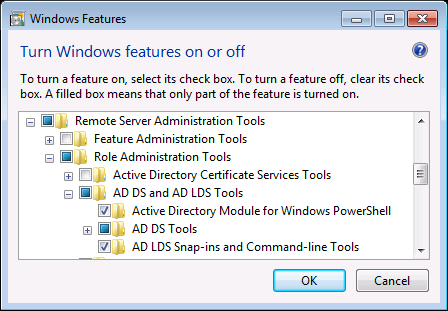
RSAT for post-1809 Windows 10
In versions of Windows from 1809 onwards the RSAT capabilities are available as optional features. There’s no need to download an external package.
To import the PowerShell Active Directory module, you must first install it. On Windows 10 post-1809, use the Add-WindowsCapability cmdlet. This enables the Rsat.ActiveDirectory.DS-LDS.Tools optional feature as shown below.
PS51> Add-WindowsCapability -Online -Name Rsat.ActiveDirectory.DS-LDS.Tools~~~~0.0.1.0The above syntax was tested on Windows 10 Build 1903 and on Windows 7.
RSAT for Windows Server 2008R2 and Later
On Windows Server, use the PowerShell ServerManager module to enable the RSAT-AD-PowerShell feature in PowerShell.
PS51> Import-Module ServerManager
PS51> Install-WindowsFeature -Name RSAT-AD-PowerShellIt’s likely PowerShell will auto-import the module when installed. But if you’d like to ensure it loads properly, you can also use the Import-Module command.
To import the PowerShell Active Directory module, run Import-Module ActiveDirectory. If the module is installed in the right place, you will receive no errors.
Connecting and Authenticating
Once the ActiveDirectory module is set up, you can then use the Active Directory PowerShell cmdlets.
Although the cmdlets interact with different parts of AD, nearly all of them have common parameters. Two of those parameters are Server and Credential.
Connecting to a Specific Active Directory Domain Controller
By default, the AD cmdlets will find a domain controller for you. However, if you need to connect to a different domain controller, you can use the Server parameter.
The Server parameter isn’t mandatory. PowerShell will attempt to find a domain controller to connect to by default. The domain controller is determined by trying the following in the listed order:
- Use the
Serverproperty of objects passed in on the pipeline. - Use the server associated with the AD PowerShell provider drive, if in use.
- Use the domain of the client computer.
You can connect to a specific domain controller by providing a value for the Server parameter. You can specify several different ADDS objects in different formats such as:
- FQDN or NETBIOS name such as domain.local or DOMAIN which will be the domain name specified
- FQDN or NETBIOS name such as server.domain.local or SERVER that will be the domain controller.
- A fully-qualified domain controller and port such as server.domain.local:3268
Connecting to Active Directory with Alternate Credentials
By default, the Active Directory PowerShell cmdlets will use a two-step process for determining the user account to connect to AD.
- Use the credentials associated with the PowerShell AD provider drive, if the command is run from there.
- Utilizing the credentials of the logged-on user.
You can also specify alternate credentials using the Credential parameter.
The Credential parameter allows you to pass in a PSCredential object. If you provide a username, you will be prompted for a password and these credentials will be used.
You can see an example below of using the Get-AdUser cmdlet using an alternate credential.
PS51> $credential = Get-Credential
PS51> Get-Aduser -Filter * -Credential $credentialWant to quickly check your Active Directory for leaked passwords? Specops has a tool that does so for free and generates a nice report as well.
You also have two possible authentication types available, controlled by the AuthType parameter. These types are Negotiate (the default) and Basic. Basic authentication is only possible over an SSL connection.
PS51> Get-Aduser -Filter * -Credential $credential -AuthType Negotiate|BasicSummary
To import the PowerShell Active Directory module is a straightforward and common process. Using the instructions provided in this article, you should be well on your way to automating all the Active Directory things!
Further Reading
- 32 Active Directory Scripts to Automate Anything
Windows OS Hub / PowerShell / How to Install the PowerShell Active Directory Module and Manage AD?
Every Windows system administrator should be able to use not only graphical AD snap-ins (usually it is ADUC, Active Directory Users and Computers), but also PowerShell cmdlets to perform everyday Active Directory administration tasks. Most commonly, the Active Directory module for Windows PowerShell is used for domain and object management tasks (users, computers, groups). In this article, we will look at how to install theRSAT-AD-PowerShell module on Windows, discover its basic features, and popular cmdlets that are useful to manage and interact with AD.
Contents:
- How to Install the Active Directory PowerShell Module on Windows 10 and 11?
- Installing the RSAT-AD-PowerShell Module on Windows Server
- Active Directory Administration with PowerShell
- Importing Active Directory PowerShell Module from a Remote Computer
- Common PowerShell Commands for Active Directory
How to Install the Active Directory PowerShell Module on Windows 10 and 11?
You can install the RSAT-AD PowerShell module not only on servers but also on workstations. This module is included in the RSAT (Remote Server Administration Tools) package for Windows.
In current builds of Windows 11 and Windows 10, the RSAT components are installed online as Features on Demand. You can install the module by using the command:
Add-WindowsCapability -online -Name Rsat.ActiveDirectory.DS-LDS.Tools~~~~0.0.1.0

Or through via the Settings -> Apps -> Optional features -> Add a feature -> RSAT: Active Directory Domain Services and Lightweight Directory Services Tools.
The RSAT package had to be manually downloaded and installed on previous versions of Windows. After that, you need to enable the AD module for PowerShell from the Control Panel: Programs and Features -> Turn Windows features on or off -> Remote Server Administration Tools-> Role Administration Tools -> AD DS and AD LDS Tools.
You must first install the WindowsCompatibility module to use AD cmdlets in PowerShell Core 6.x, 7.x:
Install-Module -Name WindowsCompatibility
Then load the module into your session:
Import-Module -Name WindowsCompatibility
Import-WinModule -Name ActiveDirectory

Now you can use AD cmdlets in your PowerShell Core 7.x scripts.
Installing the RSAT-AD-PowerShell Module on Windows Server
On Windows Server, you can install the Active Directory Module for Windows PowerShell from the Server Manager graphical console or by using PowerShell.
You can check that the Active Directory module is installed with the command:
Get-WindowsFeature -Name "RSAT-AD-PowerShell"
If the module is missing, install it:
Install-WindowsFeature -Name "RSAT-AD-PowerShell" –IncludeAllSubFeature

To install the module through the Server Manager, go to Add Roles and Features -> Features -> Remote Server Administration Tools -> Role Administration Tools -> AD DS and AD LDS Tools -> enable the Active Directory module for Windows PowerShell.
You do not need to use a local domain controller session to manage Active Directory by using the RSAT-AD PowerShell module. This module can be installed on any member server or workstation. On AD domain controllers, the module is automatically installed when the Active Directory Domain Services (AD DS) role is deployed (when the server is promoted to a DC).
The module interacts with AD through the Active Directory Web Service that must be running on your domain controller and available to clients on a TCP port 9389. Use the Test-NetConnection cmdlet to verify that this port is not blocked by a firewall on the DC:
Test-NetConnection MUN-DC1 -port 9389
Active Directory Administration with PowerShell
The Active Directory module for Windows PowerShell has a large number of cmdlets for interacting with AD. There are 147 AD PowerShell cmdlets available in the current version of the module for Windows Server 2022/Windows 11.
Check that the module is installed on the computer:
Get-Module -Name ActiveDirectory –ListAvailable
Before you can use the Active Directory module cmdlets, you must import it into your PowerShell session (starting from Windows Server 2012 R2/ Windows 8.1 the module is imported automatically).
Import-Module ActiveDirectory
Make sure that the AD module is loaded in your PowerShell session:
Get-Module
You can display a complete list of available Active Directory cmdlets:
Get-Command –module ActiveDirectory
The total number of cmdlets in the AD module:
Get-Command –module ActiveDirectory |measure-object|select count
Most of the RSAT-AD PowerShell module cmdlets begin with the Get-, Set- or New- prefixes.
- Get– class cmdlets are used to get different information from Active Directory (
Get-ADUser— user properties,Get-ADComputer– computer settings,Get-ADGroupMember— group membership, etc.). You do not need to be a domain administrator to use these cmdlets. Any domain user can run PowerShell commands to get the values of the AD object attributes (except confidential ones, like in the example with LAPS); - Set- class cmdlets are used to set (change) object properties in Active Directory. For example, you can change user properties (Set-ADUser), computer settings (Set-ADComputer), etc. To perform these actions, your account must have write permissions on the objects you want to modify (see the article How to Delegate Administrator Privileges in Active Directory);
- Commands that start with New- allow you to create AD objects (create a user —
New-ADUser, create a group —New-ADGroup, create an Organizational Unit —New-ADOrganizationalUnit); - Cmdlets starting with Add-: add a user to a group (
Add-ADGroupMember), add a Fine-Grained Password Policy (Add-ADFineGrainedPasswordPolicySubject); - Remove- cmdlets are used to delete AD objects
Remove-ADGroup,Remove-ADComputer,Remove-ADUser).
There are specific PowerShell cmdlets that you can use to manage only certain AD components:
Enable-ADOptionalFeature– enable optional AD features (for example, AD Recycle Bin to restore deleted objects);Install-ADServiceAccount– configure managed service account (MSA, gMSA);Search-ADAccount– allows you to find disabled, inactive, locked user and computer accounts in Active Directory;Enable-ADAccount/Disable-ADAccount/Unlock-ADAccount– enable/disable/unlock an account.
By default, the PowerShell cmdlets connect to the nearest domain controller in your environment (LOGONSERVER). With the -Server parameter, you can connect to ADDS on a different domain controller or in a different domain (you can display a list of DCs in another domain using the nltest /dclist:newad.com command).
The -Server parameter is available for nearly all of the module cmdlets. For example
Get-ADuser j.smith -Server mun-dc1.woshub.com
You can also use the -Credential parameter to specify alternative Active Directory user credentials.
$creds = Get-Credential
Get-ADUser -Filter * -Credential $creds
Here is how you can get help on any cmdlet
get-help Set-ADUser
You can display the examples of using Active Directory cmdlets as follows:
(get-help New-ADComputer).examples
Importing Active Directory PowerShell Module from a Remote Computer
It is not necessary to install the AD PowerShell module on all computers. An administrator can remotely import this module from a domain controller (domain administrator privileges are required) or from any other computer.
PowerShell Remoting is used to connect to a remote computer. This requires that Windows Remote Management (WinRM) is enabled and configured on the remote host.
Create a new session with the remote computer that has the AD PowerShell module installed:
$psSess = New-PSSession -ComputerName DC_or_Comp_with_ADPosh
Import the ActiveDirectory module from the remote computer into your local PS session:
Import-Module -PSsession $psSess -Name ActiveDirectory
Now you can run any commands from the Active Directory module on your computer as if the module was installed locally. However, they will be executed on a remote host.
You can add these commands to your PowerShell profile file to automatically import the module from the remote session when you start the powershell.exe console. Run the notepad $profile.CurrentUserAllHosts to open your PS profile file.
You can end a remote session with the command :
Remove-PSSession -Session $psSess
This method of importing the AD module through PowerShell implicit remoting allows you to use PowerShell cmdlets from Linux and MacOS hosts that cannot install a local copy of the module.
You can also use the Active Directory Module for PowerShell without installing RSAT. To do
this, simply copy some files from a computer where the RSAT-AD PowerShell module is installed:
- Directory
C:WindowsSystem32WindowsPowerShellv1.0Modules - File
ActiveDirectory.Management.dll - File
ActiveDirectory.Management.resources.dll
Then you need to import the module into your current session:
Import-Module C:PSADmoduleMicrosoft.ActiveDirectory.Management.dll
Import-Module C:PSADmoduleMicrosoft.ActiveDirectory.Management.resources.dll
After that, you can use all of the AD module cmdlets without installing RSAT.
Common PowerShell Commands for Active Directory
Let’s take a look at some typical administrative tasks that can be performed using the Active Directory for PowerShell cmdlets.
You can find some useful examples of how to use Active Directory for PowerShell module cmdlets on the WOSHub website. Follow the links to get detailed instructions.
New-ADUser: Creating AD Users
To create a new AD user, you can use the New-ADUser cmdlet. You can create a user with the following command:
New-ADUser -Name "Mila Beck" -GivenName "Mila" -Surname "Beck" -SamAccountName "mbeck" -UserPrincipalName "mbeck@woshub.com" -Path "OU=Users,OU=Berlin,OU=DE,DC=woshub,DC=com" -AccountPassword(Read-Host -AsSecureString "Input User Password") -Enabled $true
For detailed info about the New-ADUser cmdlet (including an example on how to create user domain accounts in bulk), see this article.
Get-ADComputer: Getting Computer Object Properties
To get the properties of computer objects in a particular OU (the computer name and the last logon date), use the Get-ADComputer cmdlet:
Get-ADComputer -SearchBase ‘OU=CA,OU=USA,DC=woshub,DC=com’ -Filter * -Properties * | FT Name, LastLogonDate -Autosize
Add-ADGroupMember: Add Active Directory Users to Group
To add users to an existing security group in an AD domain, run this command:
Add-AdGroupMember -Identity LondonSales -Members e.braun, l.wolf
Display the list of users in the AD group and export it to a CSV file:
Get-ADGroupMember LondonSales -recursive| ft samaccountname| Out-File c:psexport_ad_users.csv
Learn more about managing AD groups with PowerShell.
Set-ADAccountPassword: Reset a User Password in AD
In order to reset a user’s password in AD with PowerShell:
Set-ADAccountPassword m.lorenz -Reset -NewPassword (ConvertTo-SecureString -AsPlainText “Ne8Pa$$0rd1” -Force -Verbose) –PassThru
How to Unlock, Enable, and Disable Active Directory Accounts?
To disable the AD user account:
Disable-ADAccount m.lorenz
To enable an account:
Enable-ADAccount m.lorenz
Unlock an account after it has been locked by a domain password policy:
Unlock-ADAccount m.lorenz
Search-ADAccount: How to Find Inactive and Disabled AD Objects?
To find and disable all computers in the AD domain that have not logged on for more than 90 days, use the Search-ADAccount cmdlet:
$timespan = New-Timespan –Days 90
Search-ADAccount -AccountInactive -ComputersOnly –TimeSpan $timespan | Disable-ADAccount
New-ADOrganizationalUnit: Create an Organizational Unit in AD
To quickly create a typical Organizational Unit structure in AD, you can use a PowerShell script. Suppose you want to create multiple OUs with states as their names and create typical object containers. It is quite time-consuming to create this AD structure manually through the graphical ADUC snap-in. AD module for PowerShell allows solving this task in seconds (except the time to write the script):
$fqdn = Get-ADDomain
$fulldomain = $fqdn.DNSRoot
$domain = $fulldomain.split(".")
$Dom = $domain[0]
$Ext = $domain[1]
$Sites = ("Nevada","Texas","California","Florida")
$Services = ("Users","Admins","Computers","Servers","Contacts","Service Accounts")
$FirstOU ="USA"
New-ADOrganizationalUnit -Name $FirstOU -Description $FirstOU -Path "DC=$Dom,DC=$EXT" -ProtectedFromAccidentalDeletion $false
foreach ($S in $Sites)
{
New-ADOrganizationalUnit -Name $S -Description "$S" -Path "OU=$FirstOU,DC=$Dom,DC=$EXT" -ProtectedFromAccidentalDeletion $false
foreach ($Serv in $Services)
{
New-ADOrganizationalUnit -Name $Serv -Description "$S $Serv" -Path "OU=$S,OU=$FirstOU,DC=$Dom,DC=$EXT" -ProtectedFromAccidentalDeletion $false
}
}
After you run the script, you will see the following OU structure in the Active Directory.
To move objects between AD containers, you can use the Move-ADObject cmdlet:
$TargetOU = "OU=Sales,OU=Computers,DC=woshub,DC=com"
Get-ADComputer -Filter 'Name -like "SalesPC*"' | Move-ADObject -TargetPath $TargetOU
Get-ADReplicationFailure: Check Active Directory Replication
You can use the Get-ADReplicationFailure cmdlet to check the status of replication between AD domain controllers:
Get-ADReplicationFailure -Target NY-DC01,NY-DC02
To get information about all DCs in the domain, use the Get-AdDomainController cmdlet:
Get-ADDomainController –filter * | select hostname,IPv4Address,IsGlobalCatalog,IsReadOnly,OperatingSystem | format-table –auto
In this article, we looked at how to install and use the Active Directory PowerShell module for AD domain administration. I hope this article will encourage you to further explore this module and start automating most of your AD management tasks.
Today we’ll show you how to install and use the Windows PowerShell Active Directory Module. PowerShell AD Module is a part of the Remote Server Administration Tools (RSAT). RSAT includes all necessary management tools, command-line utilities, and Windows PowerShell modules to manage Windows Server infrastructure. You can use the RSAT-AD-PowerShell cmdlets to perform basic AD management tasks and get different information on domain users, computers, groups, and other objects. You can install RSAT-AD-PowerShell on Windows Server hosts and workstations running desktop OS versions (Windows 11, 10, 8.1, and 7).
Install PowerShell Active Directory Module on Windows Server
The Active Directory module for Windows PowerShell first appeared on Windows Server 2008 R2. It is automatically deployed on Windows Server after you installed the ADDS role (Active Directory Domain Services) when promoting a server to the domain controller. You can install this module manually on any member Windows server or workstation.
You can install the Active Directory module for Windows PowerShell on Windows Server 2019/2016/2012 R2 using the Add Roles and Features Wizard from the Server Manager. It is enough to start the wizard and at the step when selecting features, you need to select the item Remote Server Administration Tools > Role Administration Tools > AD DS and AD LDS Tools > Active Directory module for Windows PowerShell;
You can also install this module using PowerShell. Open the PowerShell console as an administrator and run the following commands:
Import-Module ServerManager Add-WindowsFeature -Name "RSAT-AD-PowerShell" –IncludeAllSubFeature
You can also use DISM to install the AD PowerShell module on Windows:
DISM /online /enable-feature /featurename:RSATClient-Roles-AD DISM /online /enable-feature /featurename:RSATClient-Roles-AD-DS DISM /online /enable-feature /featurename:RSATClient-Roles-AD-DS-SnapIns
To check the installation status of a module, use the command:
Get-WindowsFeature RSAT-AD-PowerShell
Hint. If you are using the PowerShell Core 7.x (pwsh.exe), keep in mind that the Active Directory module is fully natively compatible with this version of PoSh. But first, you need to install the WindowsCompatibility module:
Install-Module -Name WindowsCompatibility
Hint. A different PowerShell module is used to manage objects in the Azure Active Directory — Azure Active Directory Module for Windows PowerShell.
Installing the AD PowerShell Module on Windows 10 and 11
In Windows 11, Windows 10, Windows 8.1, and Windows 7, to install the RSAT-AD-PowerShell module, first you must install the appropriate version of RSAT. RSAT is available for installation for Professional, Education, and Enterprise Windows editions (Windows Home or Single Language are not supported).
On modern Windows 10 builds (1809 and newer) the RSAT became a part of Features on Demand (FoD). You can install AD RSAT Tools from the Settings menu (Settings > Apps > Manage Optional Features > Add features > RSAT: Active Directory Domain Services and Lightweight Directory Tools > Install).
Or from the PowerShell console:
Add-WindowsCapability –online –Name “Rsat.ActiveDirectory.DS-LDS.Tools~~~~0.0.1.0”
You will need to make sure that your security policies, firewalls, and proxies are allowed to access Microsoft Update servers on the Internet to download and install FOD components.
On Windows 11, you can install the Active Directory RSAT package from Settings > Apps > Optional Features > Add an optional feature > type Active Directory in the search box and select the RSAT: Active Directory Domain Services and Lightweight Directory Tools feature > Next > Install.
Or you can install the module from the elevated PowerShell console:
Get-WindowsCapability -Name Rsat.ActiveDirectory.DS-LDS.Tools~~~~0.0.1.0 -Online | Add-WindowsCapability -Online
You don’t have to reboot Windows after installing RSAT.
In order to RSAT module on Windows 7, 8.1, and Windows 10 (up to build 1803) you need to download and install a special MSU package See how to install Remote Server Administration Tools on Windows.
Then you need to enable the module (Control Panel > Programs > Turn Windows Features On or Off > Remote Server Administration Tools > Role Administration Tools > AD DS and AD LDS Tools > Active Directory module for Windows PowerShell).
Or using PowerShell:
Enable-WindowsOptionalFeature -Online -FeatureName RSATClient-Roles-AD-Powershell
Importing PowerShell Active Directory Module on Windows
The RSAT-AD-PowerShell module is automatically imported into your PowerShell session. However, on legacy versions of Windows (Windows 7 and Windows Server 2008 R2), you may get an error when running any cmdlet from the Active Directory PowerShell module:
Get-ADComputer: The ‘Get-ADComputer’ command was found in the module ‘ActiveDirectory’, but the module could not be loaded. For more information, run ‘Import-Module ActiveDirectory’.
In this case, you need to manually import the module into the PowerShell session with the command:
Import-Module activedirectory
Also, you can import the module from a remote computer/server (with installed RSAT-AD-PowerShell module) and import it into your PowerShell session (using the PSRemoting):
$S = New-PSSession -ComputerName MyDomainController Export-PSsession -Session $S -Module ActiveDirectory -OutputModule RemoteAD Import-Module RemoteAD -Force
Now you can use all cmdlets of the RSAT-AD-PowerShell module from a remote computer as if you had it installed locally. However, implicit remoting will actually work here, and all PowerShell cmdlets will be executed remotely.
The session will be active until you close the PowerShell console. You can also close the session (Disconnect-PSSession -Session $S) or remove it (Remove-PSSession -Session $S).
Now you can use the Active Directory module remotely without installing it on your computer.
To confirm the AD PoSh module is installed and imported to the PowerShell session on Windows, run the command:
Get-Module ActiveDirectory
You can display the list of available AD PowerShell module cmdlets for interacting with Active Directory as follows:
Get-Command -Module ActiveDirectory
Different versions of Windows (RSAT) have a different number of cmdlets available:
get-command -Module activedirectory|measure
- Windows Server 2008 R2 — 76 cmdlets;
- Windows Server 2012 — 135 cmdlets;
- Windows Server 2012 R2/2016/2019/2022 — 147 cmdlets.
The following is a complete list of AD PowerShell Module cmdlets in Windows Server 2019:
Add-ADCentralAccessPolicyMember Add-ADComputerServiceAccount Add-ADDomainControllerPasswordReplicationPolicy Add-ADFineGrainedPasswordPolicySubject Add-ADGroupMember Add-ADPrincipalGroupMembership Add-ADResourcePropertyListMember Clear-ADAccountExpiration Clear-ADClaimTransformLink Disable-ADAccount Disable-ADOptionalFeature Enable-ADAccount Enable-ADOptionalFeature Get-ADAccountAuthorizationGroup Get-ADAccountResultantPasswordReplicationPolicy Get-ADAuthenticationPolicy Get-ADAuthenticationPolicySilo Get-ADCentralAccessPolicy Get-ADCentralAccessRule Get-ADClaimTransformPolicy Get-ADClaimType Get-ADComputer Get-ADComputerServiceAccount Get-ADDCCloningExcludedApplicationList Get-ADDefaultDomainPasswordPolicy Get-ADDomain Get-ADDomainController Get-ADDomainControllerPasswordReplicationPolicy Get-ADDomainControllerPasswordReplicationPolicyUsage Get-ADFineGrainedPasswordPolicy Get-ADFineGrainedPasswordPolicySubject Get-ADForest Get-ADGroup Get-ADGroupMember Get-ADObject Get-ADOptionalFeature Get-ADOrganizationalUnit Get-ADPrincipalGroupMembership Get-ADReplicationAttributeMetadata Get-ADReplicationConnection Get-ADReplicationFailure Get-ADReplicationPartnerMetadata Get-ADReplicationQueueOperation Get-ADReplicationSite Get-ADReplicationSiteLink Get-ADReplicationSiteLinkBridge Get-ADReplicationSubnet Get-ADReplicationUpToDatenessVectorTable Get-ADResourceProperty Get-ADResourcePropertyList Get-ADResourcePropertyValueType Get-ADRootDSE Get-ADServiceAccount Get-ADTrust Get-ADUser Get-ADUserResultantPasswordPolicy Grant-ADAuthenticationPolicySiloAccess Install-ADServiceAccount Move-ADDirectoryServer Move-ADDirectoryServerOperationMasterRole Move-ADObject New-ADAuthenticationPolicy New-ADAuthenticationPolicySilo New-ADCentralAccessPolicy New-ADCentralAccessRule New-ADClaimTransformPolicy New-ADClaimType New-ADComputer New-ADDCCloneConfigFile New-ADFineGrainedPasswordPolicy New-ADGroup New-ADObject New-ADOrganizationalUnit New-ADReplicationSite New-ADReplicationSiteLink New-ADReplicationSiteLinkBridge New-ADReplicationSubnet New-ADResourceProperty New-ADResourcePropertyList New-ADServiceAccount New-ADUser Remove-ADAuthenticationPolicy Remove-ADAuthenticationPolicySilo Remove-ADCentralAccessPolicy Remove-ADCentralAccessPolicyMember Remove-ADCentralAccessRule Remove-ADClaimTransformPolicy Remove-ADClaimType Remove-ADComputer Remove-ADComputerServiceAccount Remove-ADDomainControllerPasswordReplicationPolicy Remove-ADFineGrainedPasswordPolicy Remove-ADFineGrainedPasswordPolicySubject Remove-ADGroup Remove-ADGroupMember Remove-ADObject Remove-ADOrganizationalUnit Remove-ADPrincipalGroupMembership Remove-ADReplicationSite Remove-ADReplicationSiteLink Remove-ADReplicationSiteLinkBridge Remove-ADReplicationSubnet Remove-ADResourceProperty Remove-ADResourcePropertyList Remove-ADResourcePropertyListMember Remove-ADServiceAccount Remove-ADUser Rename-ADObject Reset-ADServiceAccountPassword Restore-ADObject Revoke-ADAuthenticationPolicySiloAccess Search-ADAccount Set-ADAccountAuthenticationPolicySilo Set-ADAccountControl Set-ADAccountExpiration Set-ADAccountPassword Set-ADAuthenticationPolicy Set-ADAuthenticationPolicySilo Set-ADCentralAccessPolicy Set-ADCentralAccessRule Set-ADClaimTransformLink Set-ADClaimTransformPolicy Set-ADClaimType Set-ADComputer Set-ADDefaultDomainPasswordPolicy Set-ADDomain Set-ADDomainMode Set-ADFineGrainedPasswordPolicy Set-ADForest Set-ADForestMode Set-ADGroup Set-ADObject Set-ADOrganizationalUnit Set-ADReplicationConnection Set-ADReplicationSite Set-ADReplicationSiteLink Set-ADReplicationSiteLinkBridge Set-ADReplicationSubnet Set-ADResourceProperty Set-ADResourcePropertyList Set-ADServiceAccount Set-ADUser Show-ADAuthenticationPolicyExpression Sync-ADObject Test-ADServiceAccount Uninstall-ADServiceAccount Unlock-ADAccount
Using RSAT-AD-PowerShell Module
The PowerShell AD module provides an administrator with many opportunities for interacting with Active Directory objects and automating tasks (this is especially useful when performing bulk actions aimed at a large number of AD objects). You can perform all the basic operations with the AD directory:
- Get all AD properties and object attributes;
- Change object properties;
- Manage AD groups;
- Create new directory objects, etc.
The cmdlets from the Active Directory module interact with Active Directory Web Services (ADWS) on the domain controller. This role is installed on a domain controller during the promotion from a domain member server to a domain controller. The module accesses the Active Directory Web Services via TCP port 9389 (check that this port is open on the firewall).
Hint. Check if the ADWS service is running on the domain controller and is responding on port 9389 (Test-NetConnection DC01 -port 9389). Learn more about the Unable to find a default server with Active Directory Web Services running error.
If your computer is joined to an AD domain, the AD PowerShell cmdlets find the nearest domain controller to connect to based on the LogonServer environment variable. However, you can connect to any other domain controller using the -Server parameter (available on most cmdlets). For example:
Get-ADUser a.smith -Server nydc01.theitbros.com
Let’s look at a few examples of using the cmdlets of the RSAT-AD-PowerShell module.
- To get the list of AD domain controllers, run the command:
Get-ADDomainController –filter *| format-table
- You can create several AD users at once, you can import AD users from CSV. Use it together with the New-ADUser cmdlet.
To get information about an AD user, use the Get-ADUser cmdlet:Get-ADUser –identity t.muller –properties *
A similar cmdlet to display all computer attributes in AD:
Get-ADComputer –identity dc01 –properties *
- Use the New-ADGroup cmdlet to create an Active Directory group. For example, to create a new group named ItalyUsers in the specific OU, run the command:
New-ADGroup -Path "OU=Groups,OU=Italy,DC=theitbros,DC=com" -Name "ItalyUsers" -GroupScope Global -GroupCategory Distribution
- To get the AD group info, use the Get-ADGroup cmdlet:
Get-ADGroup ItalyUsers
- If you want to add a user or computer to an AD group, use the Add-ADGroupMember cmdlet:
Add-ADGroupMember –Identity ‘NY_Managers’ -Members s.adams,d.thumb,p.muller
- Use the New-ADOrganizationalUnit cmdlet to create an Active Directory OU:
New-ADOrganizationalUnit -Name "France" - Use the Unlock-ADAccount cmdlet to unlock account in Active Directory domain:
Get-ADUser -Identity bjackson | Unlock-ADAccount
- Or you can use the Set-ADAccountPassword to change domain user password or reset it:
$newPass=Read-Host "Enter the new user password" –AsSecureString Set-ADAccountPassword bjackson -NewPassword $newPass
- Check AD replication status for all domain controllers in the specific Active Directory site:
Get-ADReplicationFailure -scope SITE -target London | Format-Table Server, FirstFailureTime, FailureClount, LastError, Partner
- Find and disable AD accounts that have not logged in to the domain for more than 120 days:
Search-ADAccount -AccountInactive -TimeSpan 120 –UsersOnly| Disable-ADAccount
- For detailed help on any cmdlet from the AD-PoSh module, use the Get-Help command:
get-help set-aduser
If the computer is not a part of the Active Directory domain, the following warning appears when you try importing the AD-PoSh module:
WARNING: Error initializing default drive: ‘Unable to find a default server with Active Directory Web Services running’.
In this case, you need to specify the AD domain controller and user credentials to connect to it.
First of all, you need to get the user’s credentials to access the domain. Any authenticated domain user can view almost all AD objects properties (excluding protected Active Directory attributes).
$cred = Get-Credential
For example, to get the user’s info from the DC named TOR-DC01 under saved credentials, use the command:
get-aduser postfixsrv –server nydc01 -Credential $cred
As you can see, you have received the AD account info.
So now you can use the PowerShell cmdlets to manage and query Active Directory.
- About
- Latest Posts
I enjoy technology and developing websites. Since 2012 I’m running a few of my own websites, and share useful content on gadgets, PC administration and website promotion.

In this guide, we’ll show you how to install the Active Directory PowerShell module on almost any version of Windows. Installing the Active Directory (AD) module in PowerShell offers IT pros convenient and secure remote access to administer their AD environments, all without having to interactively log into their domain controllers.
Table of Contents
- Install Active Directory PowerShell module
- Windows 7 (Windows Server 2008 R2)
- Download and install the Remote Server Administration Tools (RSAT) for Windows 7
- Windows Server 2008 R2
- Windows 10
- Windows 11
- Windows Server 2012 R2 (Windows Server 2016, 2019, 2022, and Windows 8.1)
- PowerShell Core 6.0/7.x
- Windows 7 (Windows Server 2008 R2)
- Using PowerShell remoting and interactive sessions
- Exporting the remote AD module to a local module
- Conclusion
Microsoft does not recommend the very prevalent and pervasive practice of interactively logging into Active Directory domain controllers (DCs) to work in Active Directory. It is a fundamental security risk and is inefficient, to name two cons. The best practice recommended by Microsoft is to remotely and securely use the Remote Server Administration Tools (RSAT) arsenal, including the Active Directory module for Windows PowerShell.
Install Active Directory PowerShell module
I will assist you in the installation of this rather powerful module on the varying Windows Server and Windows client operating systems. Hopefully, this guide will help you be more efficient, especially when it comes to PowerShell scripting and productivity gains.
Windows 7 (Windows Server 2008 R2)
Wait… hasn’t Windows 7 been out of support by Microsoft for around two and a half years (at the time of this writing)? Well, yes… you’re right. No one should be using Windows 7. But, as we are ALL aware, the vast majority of enterprises and SMBs certainly have some Windows 7 machines peeking from behind the curtains.
Download and install the Remote Server Administration Tools (RSAT) for Windows 7
First, you will need to download and install the Remote Server Administration Tools (RSAT) for Windows 7. Now, if you browse to this official Microsoft Documentation link, you’ll see that the RSAT for Windows 7 is discussed. But, try as you might, you won’t find a download link (It’s just not there…).
Long story short, Microsoft has removed any official downloads for the RSAT package for Windows 7. But, thanks to web.archive.org, the past has been retained in some way: You can download the package from this link.
Once you have it, go ahead and double-click on it, click Yes to install the update, and click Accept on the license terms.
Once the installation is complete, you can move on to the next step.
Click Start -> Control Panel -> Programs, and then select ‘Turn Windows features on or off.’
Drill down to expand Remote Server Administration Tools -> Role Administration Tools -> AD DS and AD LDS Tools and put a checkmark in ‘Active Directory Module for Windows PowerShell.’ Click OK.
The installation of the PowerShell module will then begin, and it can take several minutes.
After that, it will delightfully disappear. Click Start -> Administrative Tools. At the top, you can click on Active Directory Module for Windows PowerShell.
And there you have it. I just typed Get-ADUser -filter * to test and verify that the module works:
Get-ADUser -filter *
As you can see below, the module successfully connected to my Active Directory and output all user accounts from my lab. Sweet!
Windows Server 2008 R2
So, regarding installing this on Windows Server 2008 R2, the process is fairly similar. That’s not surprising as this version of Windows Server and Windows 7 share the same codebase.
Here are the differences and the steps you need to perform. Don’t worry, it’s nice and easy:
1. Go ahead and use the same download source for the RSAT Tools and install them.
2. Open Server Manager and click ‘Add features.’
3. Scroll down and find Remote Server Administration Tools -> Role Administration Tools -> AD DS and AD LDS Tools -> Active Directory module for Windows PowerShell.
You can also use the following PowerShell commands to install the module:
Import-Module ServerManager
Add-WindowsFeature RSAT-AD-PowerShell
Done!
Windows 10
On Windows 10, Microsoft made some major headway in reducing the time to install the RSAT tools and the various headaches that come along with it – they included them in the bits of the operating system and made them installable via Optional Features.
Click Start -> Settings -> Apps -> Optional Features.
Click the ‘Add a feature‘ button at the top, and then scroll down and check ‘RSAT: Active Directory Domain Services and Lightweight Directory Services Tools‘.
Click the Install button and Windows 10 will then enable the feature.
Next, open the Windows 10 Start Menu, start typing in ‘module’ and you’ll find ‘Active Directory Module for Windows PowerShell.’ Click on it and you’re in!
I’ll run the same Get-ADUser command, the output looks familiar, doesn’t it? 🙂
Get-ADUser -filter *
Windows 11
The process on Windows 11 is very similar to Windows 10, only the layout of Settings has been updated with a few tweaks along the way. Let’s start this on one of my Windows 11 client VMs in my lab.
Click Start -> Settings -> Apps -> Optional features.
Click the ‘View features‘ button in the upper right corner, and then scroll down and find ‘RSAT: Active Directory Domain Services and Lightweight Directory Services Tools.’
Click Next and Windows 11 will install the feature for you. Then, as above, click the Start button again, start typing in ‘module’, and voila!
Click ‘Active Directory Module for Windows PowerShell.’ We can use the same Get-ADUser command to confirm permissions locally and into our Active Directory domain.
Get-ADUser -filter *
Windows Server 2012 R2 (Windows Server 2016, 2019, 2022, and Windows 8.1)
Because the install procedure is very similar between these Windows versions, I’ll cover one set of steps here. This will cover Windows Server 2012 R2, Windows Server 2016, Windows Server 2019, and Windows Server 2022 (this also applies very closely to Windows 8.1)
Reminder: Windows 8.1 goes out of support in January 2023 and Windows Server 2012/Windows Server 2012 R2 go out of support in October 2023. Be prepared!
Again, these Windows versions share the same codebase, so the steps are very similar. Let’s start out with a fresh, new, fully patched, Windows Server 2012 R2 member server in my Windows Server 2022 Active Directory Hyper-V lab.
Let’s proceed to open Server Manager, then we’ll click on Add roles and features.
Click Next a few times until you come to the ‘Select features‘ screen. As we’ve done previously, drill down to ‘Remote Server Administration Tools -> Role Administration Tools -> AD DS and AD LDS Tools -> and select Active Directory module for Windows PowerShell.’
On the next screen, click Install and we’re good!
Click Start -> Administrative Tools. Lo and behold, there it is. Open ‘Active Directory Module for Windows PowerShell.’ Let’s use the same Get-ADUser command again.
Get-ADUser -filter *
PowerShell Core 6.0/7.x
There are some other productivity features to help boost your efficiency as an IT Pro. This includes the method to install the Active Directory module on PowerShell Core 6.x/7.x. I’ll demonstrate this here on one of my Windows 10 version 21H2 VMs.
The first step is to install the RSAT tools as described above. You can follow the different steps mentioned in the ‘Windows 10’ section above.
Once you have the tools installed, you can install the latest version of PowerShell Core, which, as I write this, is PowerShell 7.2.5. You can find download links on this page.
Click Next after opening the Setup wizard. On the ‘Optional Actions‘ screen, you can see the ‘Enable PowerShell remoting‘ option. Be sure to check that.
Click Next a few more times and click Install.
After it’s installed, you can launch it from the Start menu as an Administrator.
Because the modules installed essentially ‘follow’ the varying versions of PowerShell installed, I was able to use PowerShell (Core) 7.2.5 and run the Get-ADUser command natively.
Get-ADUser -filter *
Using PowerShell remoting and interactive sessions
Another pretty powerful feature is being able to start a remote, interactive PowerShell session on your client computer while being connected to one of your domain controllers. Let me demonstrate how to do that with the following command:
Enter-PSsession ws16-dc1
So, if your IT security folks don’t want the RSAT tools to be installed on your client machine for whatever reason, you can still accomplish your tasks in Active Directory with PowerShell without having to log in to your DCs. Pretty slick trick, right?
The next option we have is to use what’s called implicit remoting. This allows you to run the AD cmdlets from your local session. However, the commands are run remotely on the DC. Run the following commands to accomplish this.
The first command below starts a PowerShell session on my DC named ws16-dc1 :
$Session = New-PSSession -ComputerName ws16-dc1
The next command imports the Active Directory module from the remote session into our local session:
Import-Module -PSsession $session -name ActiveDirectory
All the commands you run are literally being processed and running on your domain controller.
Exporting the remote AD module to a local module
The final task we can accomplish here is to export the AD cmdlets from your remote session to a local module. The sample commands below will accomplish this task by creating a local module in your Documents folder under PowerShellModulesRemoteAD.
$session = New-PSSession -ComputerName ws16-dc1
Export-PSSession -Session $session -Module ActiveDirectory -OutputModule RemoteAD
Remove-PSSession -Session $session
Import-Module RemoteAD
As is the case with the earlier steps we’ve run, we’re once again using implicit remoting, meaning all the cmdlets we use will be running remotely on the domain controller we specify. The local RemoteAD module makes a connection to the cmdlets on the DC.
Bonus tip: If you want to use this RemoteAD module on other client computers, you can copy the RemoteAD folder to the PowerShell Core module folder on other machines.
The difference between these two methods is this – PowerShell only establishes a connection to the domain controller when you use an AD cmdlet the first time. It is a persistent connection. You don’t have to add the above commands to your script or profile because PowerShell will load them automatically. However, be advised that you may need to repeat these steps if and when you update the AD module on your domain controller.
Conclusion
It’s rather refreshing to discover that some procedures IT pros need to go through are quite straightforward. Thank you, Microsoft for keeping the overall process of installing this Active Directory module for PowerShell pretty streamlined and consistent over the last ten years! Every little bit helps.
Thanks to posts like these, if you need to grab your DeLorean and go back in time, you’ll have everything you need to get your job done. Thank you for reading, and please feel free to leave any comments or questions down in the comments section below.


